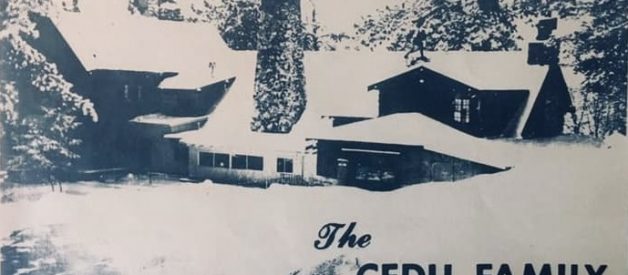
The CEDU family, a violent but influential self-help cult that initially advertised itself as a drug rehab program and, later, an ?emotional growth boarding school,? still isn?t known to much of the public. And yet, for decades, thousands of teenagers ? detained involuntarily in CEDU?s secluded California and Idaho facilities ? were stripped of their rights and abused around-the-clock by an unqualified counseling staff. A large number of these employees had once been residents at CEDU or similar programs. No one was ever charged.
Flourishing in part because it co-opted the media ? ?[t]he press is aiding in a cover-up of Cedu wrongdoings? was an allegation made against the facility in 1969 ? this long article attempts to correct the record.
We arrived far more unlucky than disordered, ?the victims of hysterical overreaction,? to borrow a line from the legal scholar, Garrett Epps.
In the 1960s, the program claimed it offered ?what some call ?the fountain of youth for youth? and an opportunity to regain normalcy.? In the 1970s, it promoted itself as a ?youth oriented drug rehabilitation center? run by ?former drug addicts? no older than twenty-five. ?All were rehabilitated by their CEDU experience,? the full-page ad boasts.
By the late 1990s, my era, CEDU had a more distinguished pitch: ?the nation?s first emotional growth boarding school.?
CEDU was indeed a great shaggy originator of ?therapeutic education.? But forced recipients of that education ? perfectly ordinary teenagers, as I recall ? weren?t students, and our backwoods behavior modification facility wasn?t a school.
 CEDU was licensed by the state of California as a group home? a fact the program tried to conceal.
CEDU was licensed by the state of California as a group home? a fact the program tried to conceal.
I was sent to CEDU?s remote compound in the San Bernardino Mountains for adolescent depression treatment. By 1999, CEDU had become an involuntary two-year program, but my parents shaved off the final eight months for something like good behavior. I returned home in the late spring of 2000. Since then, I?ve told one civilian: my longtime girlfriend, just a few years ago.
I?ve stayed silent ? until now ? because it?s too knotty and embarrassing to out. But I want to understand this institution; to see beyond my own confinement. Prior to its supposed 2005 closure, CEDU existed for nearly forty years. Decade in and decade out, it was one of the country?s most influential, harmful, and cultic residential treatment programs ? ?similar to Zimbardo?s prison experiment or Jim Jones? Guyana,? according to Psychology Today.
Investigating CEDU wasn?t liberating; it was ulcerative. Still, I attempted interviews, dug up stories in regional newspapers and magazines, and scanned all the forums and survivor sites. I also sent California Public Records Act requests. Some of these hellish records (especially ones from the California Department of Social Services) are, to my knowledge, revealed here for the first time.
But first, another disclosure: for twenty years, I?ve completely failed to understand CEDU.
I?m not alone. ?What is CEDU?? has been asked for over a half-century, leaving its questioners buried under vastly different responses. For example, in 1969, a few years after it officially launched, CEDU?s ?young people? appeared on a local news show to describe their program to a concerned and confounded SoCal public. The tape is lost, but the California Digital Newspaper Collection archived a Desert Sun advertisement for this episode.
?What?s CEDU?? the ad asks. ?Is it a hotbed of sex orgies? Or a haven toward decent living??
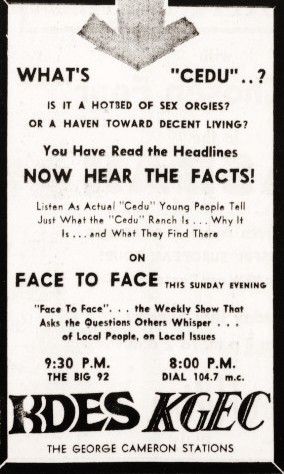 CEDU ad from 1969.
CEDU ad from 1969.
My parents ? many parents ? missed CEDU?s ?hotbed of sex orgies? question. Instead, to them, it was a sort of touchy-feely kibbutz with hippie counselors at outside tables reading aloud passages of Jonathan Livingston Seagull.
This easy narrative can be found throughout the media, too. When CEDU isn?t sensationally misdescribed as a ?controversial home for social dropouts? (the San Bernardino Sun, 1968) or a ?scandal-ridden boarding school? (the Jewish Journal, 2015) or a ?now-shuttered behavioral school? (ABC News, 2019), it?s dwindled down to a therapy camp with a hippie vibe, a retro eccentricity. At CEDU, Forbes observed in 2002, a ?Sixties mindset still prevails.?
Ah, and wasn?t that mindset groovy. Before beginning to write this article, I came across CEDU in an old issue of Billboard magazine. It?s 1973, and Bo Donaldson and The Heywoods ?will appear live at the CeDu school in Running Springs, Calif.? The Billboard blurb continues: ?CeDu is a public, non-profit corporation functioning as a rehabilitation center for emotionally disturbed youths who have experienced serious drug involvements.?
You may recall Bo Donaldson and The Heywoods, launched by the Osmonds, from their 1974 hit, ?Billy, Don?t Be A Hero.? Or, perhaps, you don?t. By 2011, Rolling Stone listed that tune ? ?insipid?drivel? ? on its 10 Worst Songs of the 1970s.
When I discovered the archived concert announcement, despite the wonky spelling of a wonkier name, I felt momentarily satisfied with the program?s description. But anyone who has lived at CEDU ? a ?closed system,? to quote Philip Elberg, the former president of the International Cultic Studies Association, where ?amateurs operat[ed] an unregulated prison camp? ? knows a moment of clarity is followed by decades of incomprehension.
First, the only ?non-profit? part of CEDU was its residents couldn?t hold money. Also, nearly every genre of music was forbidden ? just humming a degenerate, ?unacceptable? tune was a punishable offense. The music I recall hearing? A non-stop soundtrack of soft rock and easy-listening songs blasted throughout CEDU?s hysterically violent large-group awareness training.
According to a CEDU brochure from the early 1970s: ?Music is used extensively as a tool to experience feelings.? Instead of the standard thrash-metal music torture, I was deafened by John Denver and Neil Diamond and Randy VanWarmer and sleep-deprived teenagers screaming themselves into convulsions.
So, how did Bo Donaldson and The Heywoods get this gig? Did they arrive in their fire-sequined bell-bottom jumpsuits? (Completely out of agreement with the CEDU uniform.) Above all, why would an unapologetically self-enclosed facility allow a public show?
Here?s the harder question: why was a fifteen-year-old from Chicago?s suburbs ? a teen lacking any ?drug involvements? ? immured in a mountain-town rehab half a country away from his home?
The Children Under Its Care
?CEDU, as the drug institute is called,? a 2001 Los Angeles Times cover story noted, ?was the brainchild of Mel Wasserman, a Palm Springs furniture store owner who had sponsored recovering addicts at Synanon.?
Wasserman?s role was murkier than mere sponsorship. Synanon, after all, was an ass-backwards rehab that turned itself into a religion. But CEDU?s founder most certainly was a Synanite. In a 1972 letter endorsing CEDU as a ?serious and dedicated treatment establishment for drug addicts,? Dr. Frank A. Seixas wrote ?[t]he director, Mel Wasserman, had previous experience with Synon [sic] after which the therapy is modeled.?
(Seixas, it should be noted, was ?an expert on alcoholism and a leader in the effort to classify it as a medical illness,? according to his New York Times obituary.)
Other individuals in CEDU?s cabal were from Synanon, too. For example, a gruff heroin addict from Brooklyn, Bill Lane, joined Synanon in 1962 ? one of its first and youngest members. While there, he met Mel Wasserman, ?a big contributor, big donor, a good friend, big supporter of Synanon,? Lane said in a recent BlogTalkRadio show.
The two went on to ?develop? CEDU: Mel as its founder and Lane, according to a 2005 profile with the cloyingly-titled website, StrugglingTeens.com, ?mov[ing] into admissions and every other aspect of the organization, culminating in his becoming president.?
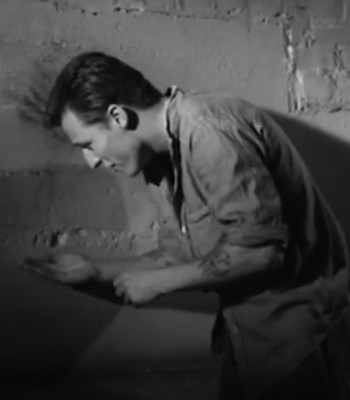 Screenshot of Bill Lane acting in an early Synanon promotional video.
Screenshot of Bill Lane acting in an early Synanon promotional video.
Mel?s drug institute ? which moved from his Palm Springs home to a ranch in Reche Canyon to a lodge in Running Springs ? was, if anything, one rolling allegation since the late sixties. ?From the first months of the program until the final days of the CEDU schools nearly forty years later, Wasserman?s educational philosophy and methods were always draped in controversy,? note the authors of Second Shelter, a book on residential therapeutic treatment.
Second Shelter correctly mentions CEDU?s ?therapeutic approach borrowed heavily? from Synanon, but suggests ?Wasserman employed a milder version.? Similarly, in a 2009 Bend Bulletin story, a onetime CEDU admissions director stated, ?Mel Wasserman was influenced by Synanon, and so used the confrontation model watered down quite a bit in the founding in CEDU.? More striking, The LA Times cover story very mistakenly ? very horrendously ? claimed ?Wasserman eschewed Synanon?s confrontational approach to therapy.?
These are repulsive errors. As it turns out, you can?t actually modify behavior modification ? especially when it?s fueled by rage and meant for children. And, anyway, if Mel the Would-Be Guru really wanted to water down Synanon (or avoid its ?cult-like trappings?) he probably shouldn?t have named his institute after its founder.
The Church of Synanon, as Gizmodo smartly put it, was ?a tyrant?s ant farm masquerading as a grand experiment with the good life.? That tyrant was Charles E. Dederich, a hypermasculine, addict-alcoholic who ran Synanon like, well, a drug lord.
Under Dederich?s rabid, loopy leadership, Synanon went from ?treating? substance abusers with attack therapy to forcing them into vasectomies and abortions and divorces and partner-swapping and head-shaving. Chuck?s good life also came equipped with a militia, ?The Imperial Marines,? and ? as People Magazine wrote in 1978 ? ?rumors of an arms cache worth $300,000.?
This People article includes a parenthetical Dederich quote. ??Brainwashing is a very apt term,? [he] once observed. ?We get very dirty brains in here.??
Not a clever line, but still troubling to read. Mel Wasserman and Bill Lane were those dirty brains. They were also cold, savvy businessmen ? dirty brains clear enough to establish a program based on Synanon?s duplicatable bits.
 Mel Wasserman, date unknown.
Mel Wasserman, date unknown.
I?m still struggling to understand whether this was a steal or a tribute or both. Nevertheless, there is overwhelming evidence that CEDU was an acronym for ?Charles E. Dederich University.?
(A quick word on spelling: I grew up with ?CEDU? in all-capital letters, and will continue writing it in uppercase. However, variations existed throughout its history. Mostly, ?Cedu? and ?cedu.?)
At any rate, my parents learned about the CEDU-Synanon relationship in 2015. At first, they were confused and incredulous. Then they were confused and devastated.
I wondered why my parents never asked about the program?s bizarre name. ?We believed what we were told,? my mother said. The common explanation was that CEDU stood for: ?See yourself as you are and do something about it.? Whatever the hell that means.
 Photo from a 1973 brochure.
Photo from a 1973 brochure.
For obscure reasons, this ?See yourself/Do something? line was widely accepted. And yet a 1968 San Bernardino Sun article says that ?Cedu was a manufactured name [Mel Wasserman, his wife, and early members] gave to encounter groups.? Another 1968 piece in the same newspaper says a resident?s ?free time is spent in ?cedus? ? encounter sessions in which young people work out their problems and discover themselves.?
I don?t know when CEDU officialdom cooked up their marketable slogan, or why the outside world ? reporters included ? ignored or excused its unmissable sketchiness. (The obvious question: if the facility?s name was an abbreviated motto, why not spell it ?Seedo??) One thing is clear, though: Charles E. Dederich often went by his full initials.
As the preeminent Synanon expert, Paul Morantz, says in a filmed interview, ?probably the biggest reference to [Dederich] was ?CED,? particularly in writing.?
In the summer of 1968, according to the San Bernardino Sun, CEDU was ?operating with a nonprofessional staff and taking in teenagers by the dozens. Wasserman and his wife [took] the role of parents for their ?family.??
I was dispatched to CEDU in January, 1999. By then, the program was advertising itself as a ?Family of Services? and taking in teenagers by the hundreds. (In addition to its California lodge, CEDU ran a few sister ?schools? and a wilderness program in Idaho.) The larger family still operated with nonprofessional staff, but Wasserman and his wife had become something like estranged grandparents.
 Mel Wasserman featured in a 1972 NBC News segment on CEDU.
Mel Wasserman featured in a 1972 NBC News segment on CEDU.
According to Second Shelter, the nineties were a difficult time for this niche business. CEDU ?began experiencing financial difficulty and a growing number of complaints against the school and staff members for mistreatment of students.? (Spend a few hours searching the California Digital Newspaper Collection, however, and you will see the exact same financial difficulties and complaints going back to the 1960s.)
As always, though, CEDU persisted, ready to mop up every allegation. It remained open after a small group of concerned counselors at the Running Springs site ? the ?CEDU Underground? ? reported abuses to California?s Child Protective Services and the San Bernardino County District Attorney?s Office. The Underground?s concerns fanned out across the entire CEDU program. But, as one of those ex-counselors, Sabro Foster, related it to me, staffers who questioned CEDU?s methods were driven out. Foster quit; others were fired.
As for the investigations they tried to spark? Foster recalls ?two individuals from different offices? interviewed him. ?After that, I never heard a thing.?
 According to sworn testimony in 2009 from Charles Wyatt, a San Bernardino County Sheriff?s Sergeant aware of CEDU since 1976, the program destroyed evidence and generally acted above the law.
According to sworn testimony in 2009 from Charles Wyatt, a San Bernardino County Sheriff?s Sergeant aware of CEDU since 1976, the program destroyed evidence and generally acted above the law.
Smug and unsinkable, CEDU remained open even after a 1998 Spokesman Review piece reported lawsuits ?for fraud, racketeering and battery.? The article, in length, also described a 1997 riot at one of CEDU?s Idaho campuses. ?The riot was not reported to Idaho health and welfare officials,? the Review pointed out. But Child Protective Services heard of the revolt and investigated. ?It is our belief,? the health and welfare report read, ?that the cause of the riot was the result of frustration by students over mistreatment by a number of staff.? Allegations of abuse and neglect were ?found to be valid,? the report concluded.
An organized rebellion should have been CEDU?s final gtterdmmerung. Instead, in 1998, it was acquired by the Brown Schools, another grisly corporation ?whose methods,? the Austin American-Statesman emphasized, were ?repeatedly targeted by state regulators and private lawsuits.? Seven years later, the Brown Schools filed for liquidation and CEDU abruptly closed.
?This bankruptcy,? an incisive CEDU parent wrote in 2005, ?is more about child abuse than it is about cash flow.? After suing the program for, among other things, the ?false imprisonment of his daughter,? the father argued that ?Brown/CEDU first made, and then lost, a lot of money isolating kids in remote locations. These isolation practices?is the heart of the Brown/CEDU program.?
The regional newspaper, the Mountain News, documented CEDU?s ruin. Far from denying all wrongdoing, ?CEDU reportedly admitted it had systematically violated the rights of children under its care.? The Mountain News piece added that, fittingly, ?a copy of that document was not made available at press time.?
That was in 2005. It?s still not available.
Friends of CEDU
While I?ve heard their narrative before, I recently asked my parents why I was sent off to CEDU. ?Because you tried to kill yourself,? my mother answered without hesitation.
I don?t believe my low-level overdose was a suicide attempt. I also acknowledge that the motivation to swallow a few extra pills could only be explained by a ninth-grader. Maybe it was a cry for better help. Maybe it was a provocation ? another suburban teen testing the limits of his mood-altering meds. Or maybe prescribed psychiatric drugs weren?t just ineffective but causing depressive symptoms. The day before I overdosed on Zoloft, my father took a photo of me, a close-up. I look lifeless, med-drenched. My eyelids are dry and swollen. I have allergic shiners. This, to me, isn?t an image of ?despair beyond despair.? It?s a warning sign of overmedication.
Like other North Shore youths, I had a diagnosis: generalized anxiety disorder. This was no full-blown mental illness. I was ? am ? a shpilkes-filled only-child whose general anxieties could have been treatable with, say, breathing exercises and a daily walk. Instead, in eighth grade, a child psychiatrist and pharmacologist, Dr. A, put me on Klonopin, a gruesome anti-epileptic drug.
My parents can?t recall how they found Dr. A, only that he was a ?researcher.? His independent practice ? above the DMV ? seemed to overlap with his other career at a global pharmaceutical company. From the start, Klonopin was a hellscape of adverse effects. Not surprisingly, Dr. A, a drug developer, was unconcerned.
By early freshman year, I had second diagnosis: mild depression. In addition to Klonopin, I lurched from SSRI to SSRI until landing on Zoloft. Dosed-up on dangerous, unneeded Benzos and antidepressants, I started seeing a therapist.
CEDU was the therapist?s recommendation ? his only recommendation. He counseled my parents soon after my overdose, conveniently with a brochure at hand. This facility, he claimed, was the best place for depression treatment.
After the therapist?s referral, my parents consulted with another North Shore family ? let?s call them ?the Settles? ? whose son was a recent CEDU ?graduate.? This wasn?t so much a second opinion as a queasy continuation of the first. My therapist had recommended CEDU to the Settles, too. (Incidentally, the Settles were also my paternal aunt?s neighbor.)
I still remember their CEDU fanaticism and boosterism. The program had saved their family, an assertion the couple made repeatedly and publicly. Mama and Papa Settle even helped establish a charitable organization, ?The Friends of CEDU,? to assist with tuition. My parents, however, took out a loan from American Education Services. They were paying it back until 2012, seven years after the facility closed.
What I believed as a teenager is my belief now: CEDU committed family annihilation without the actual murder. Yet maybe the Settles, decades later, are a tighter, stronger family ? even if, I?m told, Mama and Papa are long divorced and their foundation renamed itself, ?The Friends of Families with Children in Crisis.?
(This past winter, I contacted the Foundation, eager for a comment about CEDU?s legacy. No one responded.)
 Countless parents enrolled their children at CEDU because the program claimed to treat adolescent depression. However, in deposition testimony, one former staff member was unaware of the program?s depression treatment and a second staffer admitted CEDU ?would actually not try to treat a depressed child.?
Countless parents enrolled their children at CEDU because the program claimed to treat adolescent depression. However, in deposition testimony, one former staff member was unaware of the program?s depression treatment and a second staffer admitted CEDU ?would actually not try to treat a depressed child.?
After the Settles? endorsement, my parents scheduled a CEDU tour. My mother journeyed alone. When she arrived on campus, her guide wasn?t a CEDU staffer ? she doesn?t remember meeting adults ? but two ?older students,? one male, one female. An instant bond: the female resident happened to hail from a suburb eight miles south of my hometown.
In a facility housing teenagers from all over the country, it was no coincidence that my disorientated and duped mother was now connecting with a neighbor. What?s more, this neighbor?s family had also discovered CEDU via my therapist. (I?d soon learn there was a batch of North Shore teenagers he helped enroll, and I?ll always wonder if CEDU paid him for his professional referrals.)
Here?s another dizzying thought: when I reached ?older student? status, I had to give campus tours, too. I barely remember them. But once I was fully obedient, a walk-through with parents of a prospective resident was an expectation, a privilege.
The inmates didn?t just sell the prison, we also maintained it. Half the day was consumed by groundskeeping and house chores ? relentlessly staging a home wherein we had no personal belongings; keeping the facility in showing-ready shape.
My mother said she left the forested property thinking ?it was pretty.? There was never a glimpse behind the facade. She didn?t ask if counselors were licensed, if therapies were barbarous. She didn?t see an adult continuously punishing ? and cuddling with ? a child. She didn?t overhear CEDU?s very own lingo. (A forum for survivors of abusive teen programs has a wiki article on CEDU?s secret language. Its ?partial list of terms? is currently at 120.) And the docents never leaned in close and whispered, ?get as far away from this place as you can.? Still, the uprooted North Shore neighbor offered a friendly tip: don?t hire a youth transport service. Children need a ?humane? deportation, she insisted.
My committal was a group effort. But, ultimately, it was CEDU children ? teen kapos acting like California real estate agents ? who closed the deal.
A Quick Meal in Calabasas
?As I recall,? my father wrote in a 2017 email to me, ?your entry into CEDU was without incident.?
After a leisurely enrollment, my father, then fifty-years-old, and my brawny thirty-something cousin escorted me to CEDU. My father doesn?t remember paperwork, or meeting counselors or residents, or getting a campus tour. In fact, he and my cousin left the compound not long after delivering me there. The two, he said, ?stopped in Calabasas for a quick meal,? before my father returned the rental car and flew back to O?Hare. The humane deportation was a daytrip.
I genuinely believe my child development ended in CEDU?s admin office. Entirely unknown to my family, the first counselor I met ? a smirking, leering forty-something with a boyish haircut and a southern-preacher voice ? strip-searched and cavity-searched me.
The CEDU move-in process also involved a Polaroid mugshot, handing over civilian clothes, and signing a ?student procedures, rules, policies, guidelines, and rights? form.
The agreement form was a sacred pact between a new enrollee and CEDU. The child agrees to give up, for example, ?magazines/books? and ?credit cards/money? and ?purses/wallets? and ?cameras? and ?radios.? In return, CEDU promises it will provide a ?safe, healthful, and comfortable? new home that is ?free from corporal or unusual punishment, infliction of pain, humiliation, intimidation, ridicule, coercion, threat, mental abuse, or other actions of a punitive nature.?
Once signed, a staffer would conceal the agreement form and CEDU would begin ignoring its own policies.
 Part of CEDU?s two-page agreement form revised in 1998.
Part of CEDU?s two-page agreement form revised in 1998.
I remember nothing about my CEDU move-in except a closed-door cavity search in a cramped, dingy office.
More boys than you could count were inspected by the male staffer who searched me. Like most, I immediately sensed he was a sleazebag. And despite allegations of serial pedophilic behavior ? far worse than invasive, humiliating searches? he is still working with children. This time, at a private Mennonite high school in Pennsylvania.
Remarkably, over the years, students and parents at Dock Mennonite Academy have contacted CEDU survivors wishing to understand their handsy educator with sexual secrets. It?s ?apparent he has an affinity for boys,? the father of a Dock Mennonite high schooler wrote to me in February, 2019. And yet, as it was in CEDU-world, Counselor Sleazebag remains locally powerful and unprosecutable. According to the father?s testimony, the ?community remains idle.? He went on: ?It?s very concerning to me to see the overall pattern of [Counselor Sleazebag?s] behavior, as it aligns with that of a sexual predator.?
How a distressed Dock Mennonite parent described a former CEDU counselor to me in 2019 is how I failed to describe him ? and the entire program ? to my parents in 1999: an ?effective manipulator? who ?keeps his victims silent.?
The overwhelmingness of CEDU Day One is impossible to distill. But once properly installed there, a startled contactee in the San Bernardino Mountains, I remember approaching Counselor Sleazebag to demand a phone call. CEDU wasn?t a winter camp for young depressives, but an all-purpose detention center. My parents needed to know they?d been conned.
A youthful mistake, assuming I could freely call out of the facility.
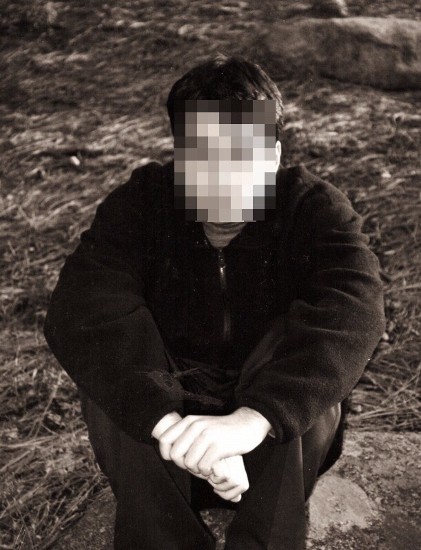 The author as a fifteen-year-old CEDU resident.
The author as a fifteen-year-old CEDU resident.
Every two weeks, for the duration of my stay, a family liaison would monitor a fifteen minute telephone call with my parents. (The only calls I could make.) I remember this swaggery woman would push a box of Kleenex towards me when I?d inevitably start crying. She also might end a call ? these were ?privileges? ? if I disclosed anything too unsavory (or illegal), or my tone was too argumentative, or I specifically talked about CEDU?s carefully guarded treatment.
I remember my family liaison as a kind of mountain ogress. My parents, rarely seeing her in person, describe her as a callous, judgmental doom-monger ? more of a one-woman call-center than a caseworker ? who repeatedly decentered them, stressed the importance of our family?s separation, and passed on information she collected from counselors. (It?s worth mentioning that I never saw counselors take notes.)
At best, though, our liaison was a shrewd huckster following a script. For example, during a strained, superficial parent-chat, if I managed to blurt out a truth or I asked ? begged ? to get fetched out of CEDU, the liaison would later spin my behavior into a manipulation. ?She kept telling us CEDU kids were untrustworthy, and they will say anything to leave the program,? my parents both acknowledged.
I knew that every phone call was a losing struggle. However, until very recently, I didn?t know my disclosures in ?raps? ? attack therapy ? were occasionally relayed to my parents. (This gives me a cold chill. ?What?s said in a rap stays in a rap,? was a fundamental rule.) In chastising calls from a go-between, often received during the workday, my parents would learn unpleasant confessions about their child. ?I?d wait for a phone call and cringe,? my mother admitted.
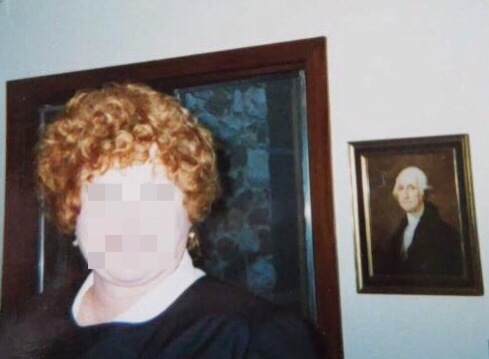 The author?s family liaison.
The author?s family liaison.
Liaisoning with my parents was an opportunity to make them feel oblivious and out of their depth, to keep the family disassembled. Naturally, my mother and father would beat themselves up about their parenting errors, never once suspecting this stranger?s updates were spectacularly wrong or my confessions were false.
All my confessions were false.
A few times a week, for an entire afternoon, residents were attacked into self-revelation. A rap session is described as ?peer counseling? in one of CEDU?s impressively fictional brochures. It reality, children underwent Synanon?s ?The Game.? From Cabinet Magazine:
The Game consisted of a dozen or so addicts sitting in a circle. One player would start talking about the appearance or behavior of another, picking out their defects and criticizing their character. But as soon as the subject of the attack tried to defend him-or herself, other players would join the barrage, unleashing a no-holds-barred verbal onslaught. Vulgarity was encouraged ? ?talk dirty and live clean,? said Dederich ? and so the other members would accuse the defendant of real and imagined crimes, of being selfish, unthinking, of being a no-good, ugly, diseased cocksucker who was too weak to go straight and was too much of an asshole, junkie, cry-baby motherfucker to admit it. Faced with this unrelenting group assault, the recipient would eventually have little choice but to admit their wrongdoing and promise to mend their ways. Then the group would turn to the next person and begin all over again.
There is one difference between raps (formerly ?cedus?) and the Game: ours were facilitated by predatory adults attempting to uncover shameful secrets in children ? secrets most of us didn?t have. Regardless, after getting ?blown away,? we were forced to ?run our anger? ? stare at the carpet and scream our brains out ? and make confessions. Once we had ?taken care of our feelings,? a counselor?s bullying rage would move on to the next child.
Throughout hundreds of flamboyant rap sessions, every resident learned a central fact of CEDU: lies couldn?t be disentangled from personal development.
Another survivor expresses something quite similar in a filmed 2008 interview. After mentioning the ?rewards? counselors offered for dishonesty in raps, she says, with incredible clarity, ?I?ve told people this ? I feel like CEDU trained us to lie.?
Chuck Dederich would have been pleased. According to Synanon.org, lying and exaggerating were listed among his ?favorite techniques in the Game.?
Incorrigible Youngsters
In May of 2017, exactly seventeen years after getting extricated from CEDU, I went on a fact-finding mission. First, I submitted a Public Records Act request to the California Department of Justice, seeking documents about a specific investigation.
In 2009, according to the Alpenhorn News, California DOJ investigators researched ?the possibility that serial child molester and child murderer, James Lee Crummel?had years of free, unsupervised access to the students at the now defunct CEDU School in Running Springs.?
Apparently, Crummel assisted a roving psychiatrist named Burnell Forgey. A DOJ Missing Person Investigator ?confirmed that Forgey was a contracted psychiatrist at CEDU, and it appears that Crummel also accompanied him when he visited [the facility].?
This story, which continues to keep me awake at night, was written by a ?[r]etired San Bernardino County Sheriff?s Sergeant and veteran crime reporter.? I imagine this is why the Alpenhorn News, a ?boutique publication in the Lake Arrowhead Mountain Communities,? lists the reasons for CEDU?s collapse in greater detail than bigger papers and magazines. For example, instead of the vague but printable ?allegations of abuse,? you read about ?allegations of sexual and physical abuse of the students, by other students and staff members.?
Put another way: CEDU hadn?t just inadvertently let in a couple of sexual predators. The facility itself was designed for predation.
Burnell Forgey was arrested in 1998, ?suspected of having oral sex with [a] teenager under his care while Crummel allegedly sodomized and orally copulated the boy,? The LA Times wrote that year. The boy wasn?t a CEDU resident ? Forgey worked at various SoCal adolescent programs ? but police were investigating ?other possible victims of an 80-year-old psychiatrist? and his ?notorious pedophile? accomplice and travel companion.
Over a decade later, investigators finally made it up the mountain. Specifically, they were looking into a connection between Crummel on campus and two CEDU boys, in 1993 and 1994, disappearing from it. (Though unrelated to this case, I should mention that another CEDU boy, Daniel Yuen, went missing from the same campus in 2004. By his mother?s own account, Daniel Yuen had been enrolled at CEDU for ?about two weeks? before vanishing.)
Anyway, why it took so long to launch an investigation, I?ll never understand. But by 2009, Forgey was dead, CEDU was closed, and James Lee Crummel was a few years away from hanging himself in his San Quentin death row cell.
A CEDU survivors? page says Burnell Forgey worked at my facility in the mid-nineties. If nothing else, I hoped the DOJ documents would tell me exactly when these vile men with Dickensian surnames capered around the property.
My request, however, was declined. ?Complaints and investigative records are confidential law enforcement records of the Attorney General,? I was told. Furthermore, these records ?do not lose their exempt status due to a failure to prosecute, or the close of an investigation.?
After my failed DOJ records request, I contacted the Twin Peaks Sheriff?s Station, curious if old files were still available. ?Over the years,? the Mountain News wrote, ?the CEDU campus [had] generated a large number of calls to the Sheriff?s Department for everything from runaway students to reports of abuse and incorrigible youngsters.? That 2005 piece went further. ??Since January,? Corporal James Bergendahl from the Sheriff?s Twin Peaks station stated, ?we?ve probably averaged 30?40 responses to CEDU a month.??
First, ?incorrigible youngsters? stings a bit. Maybe this incorrigibility existed because youngsters, for decades, unsuccessfully reported abuse. Or, perhaps, youngsters were incorrigible because sheriff?s deputies kept hauling them back to the tripped-out treatment center they were struggling to escape from.
Second, ?30?40 responses? per month? According to the California Department of Education?s Private School Directory, archived back to 1999, when I was a resident, CEDU had sixty-eight enrollees in grades 9?12 and thirty-one in grades 7 and 8.
(CEDU, licensed to ?serve? children as young as nine-years-old, launched a ?middle school? in the early 1990s. This program was ?[s]pecifically designed for the prepubescent child and young adolescent,? its old website states.)
The Private School Directory is suspiciously missing data collections for CEDU?s final two years, but I imagine the place was even more thinly populated. (By 2005, one of its Idaho compounds, Rocky Mountain Academy, evidently had nineteen kids enrolled.)
Why so many responses towards its end in Running Springs? Who made these calls? Were incorrigible youngsters now smuggling in cell phones?
I contacted the Twin Peaks Station four times. They didn?t respond once.
I assumed the sheriff?s office would ignore me. During my time, and well before it, local law enforcement officials knew the hell inside CEDU but went on pretending it was a pricey boarding school full of adolescent outbursts. So, while I hounded the mountain cops, I also emailed the California Department of Social Services. A reply arrived swiftly, but said, with CEDU twelve years gone, complaint investigations and inspection reports might be unobtainable. CDSS, I was told, is not ?obligated to keep closed files for that long.?
How do I set the record straight if the record has been declined, ignored, or deleted?
I pushed harder, reminding CDSS that, not so long ago, they had a hand in closing this facility. Surely there is a file somewhere. Seven weeks later, one was unearthed in a Riverside office. But before any documents could be released, I had to mail CDSS a check. ?Charges are waived,? I was told, ?if the request is limited to 49 pages.? The CEDU file was 128 pages.
There?s something incredibly grotesque about paying a California state agency to read about CEDU violations. It didn?t help that, by chance, I sent my check on National PTSD Awareness Day.
Eventually, CDSS mailed a giant mess of unstapled and unnumbered photocopies. No cover letter. These reports ? some typed, some handwritten ? only spanned twelve years, from 1993 to 2005. Throughout, children are addressed as ?clients.?
Right at the start (or end), in a note dated 2/17/2005, I learned that one of CEDU?s teachers ? also, from what I recall, its academic director ? didn?t have a teaching certificate. ?There was no evidence of active pursuit for credentials in an accredited coursework,? the investigator added.
So far, so CEDU.
Although the facility called itself a high school, and brochures boasted a ?college preparatory academic program,? residents ? clients ? only received a smattering of substandard classes, many taught by counselors. The simple truth: CEDU academics (if that?s the word) were considered a privilege, not a necessity. The real education was its ?emotional growth curriculum.?
(As part of the reporting for this story, I had several email and phone dialogues with the California Department of Education?s Private Schools Office. I requested personnel documents, complaints against teachers, and student records. CEDU, I learned, ?operate[d] outside the jurisdiction of the California Department of Education.? Consequently, they had absolutely nothing. I then tried the San Bernardino Mountains? school district, Rim of the World Unified. Nothing there either. ?I also was not able to find out who would have archived their records,? the Executive Secretary to the Superintendent wrote me. And while basic CEDU info ? phone number, address, zip code, enrollments by grade, etc ? can be found via the Private School Directory, its website stresses that ?[i]nclusion of a school?should not be interpreted as meaning that the State of California, the State Superintendent of Public Instruction (SSPI), the State Board of Education, CDE, or any other agency has made any evaluation, approval, or endorsement.? This fact was confirmed in a call with the Department of Education. ?So there?s a lot of questionable schools that could just end up in the directory?? I asked outright. ?They can ? especially if they are private,? was the response.)
At any rate, I read about thirty pages of CDSS reports, vomited, then skipped to my era, 1999?2000. The first one detailed an unnamed child?s sexual abuse by a staff escort. ?The allegation is substantiated,? the investigator concluded. Also substantiated: a multipage complaint about CEDU allowing ?staff to take children to staff?s homes or to hotels for care and supervision.? This practice ?was not approved by the licensing agency nor was it ever stated in the program statement.?
Equally distressing, a two-page report stating ?many employees? hadn?t been ?fingerprint cleared or fingerprinted,? including all contracted psychiatrists and therapists. (One-on-one counseling with a mental health professional was a weekend extracurricular ? an option forced upon the institution by outsiders. An additional cost, these CEDU bit players billed parents directly.)
Then there?s this report: just one week before I turned sixteen-years-old, CDSS was on campus to discuss a number of ?incidents,? mostly ambiguous in the notes, but clearly all-encompassing, that had occurred since January, the month I arrived. ?The facility has not reported special incidents to the licensing agency,? the investigator lectured. ?Most recent being client runaways.?
For me, what?s deeply concerning isn?t that CEDU withheld incidents from the Department of Social Services; it?s that the Department withheld CEDU?s deficiencies from parents.
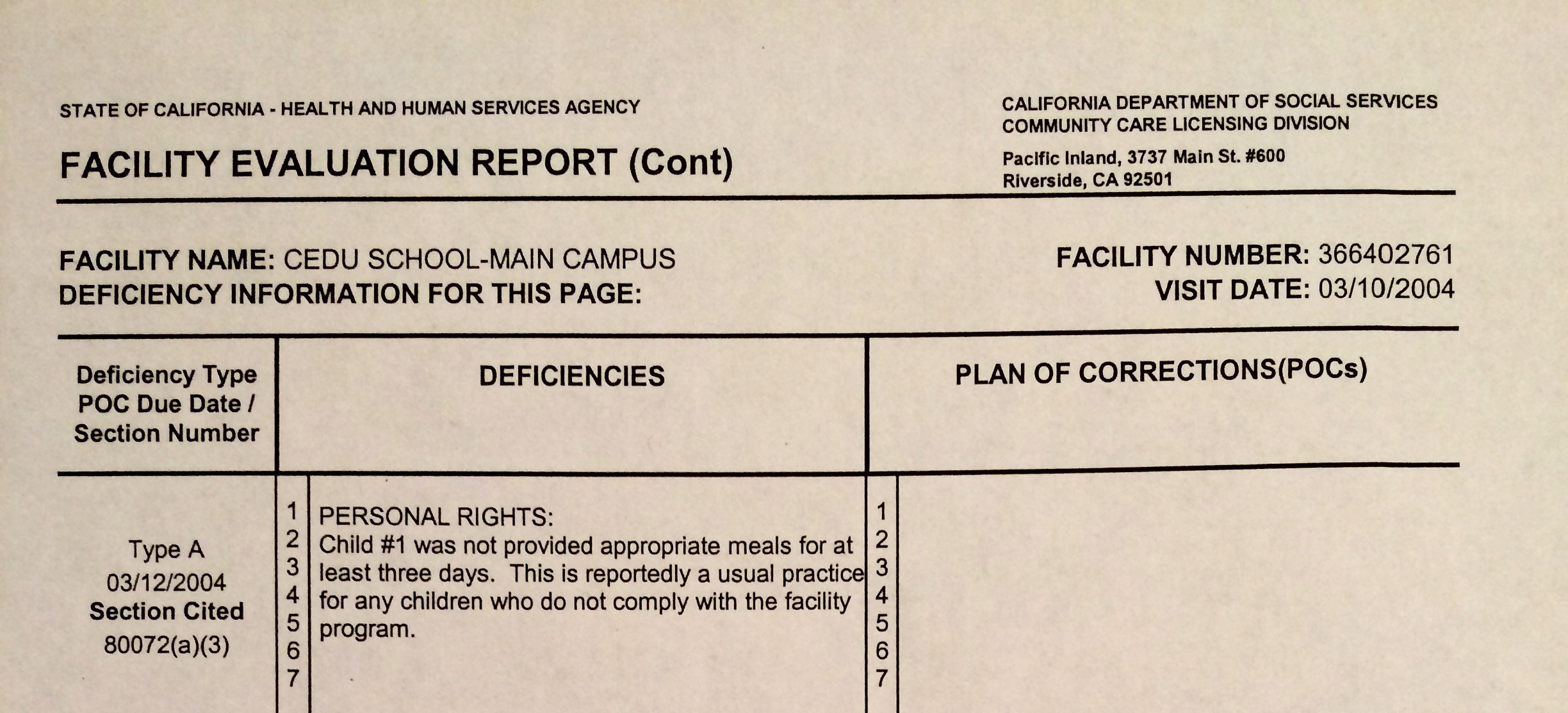 Part of a CEDU evaluation report. ?Type A citations,? a Community Care Licensing Division glossary explains, ?are issued for the most serious types of violations.?
Part of a CEDU evaluation report. ?Type A citations,? a Community Care Licensing Division glossary explains, ?are issued for the most serious types of violations.?
All through the records, the readable ones, you see substantiated allegations of sexual, verbal, or physical abuse, rampant violations of children?s personal rights, and inadequate staff background checks. Another recurring deficiency: adults failing to meet health and safety standards. Up until 2005, facility evaluation reports read: ?no proof in file of first aid training or certificate.?
In the thick of all this, CEDU representatives offer corrective actions ? many written more illegibly than investigators? scribbled reports. ?CEDU has certified first aid training and will schedule training in 30 days.? ?Facility will send a plan of correction within 24 hours.? ?Facility will have staff training on personal rights.? ?Facility staff shall immediately take seriously and follow-up on all client complaints regarding sexual activity.? ?By 11/8/00 I will have reminded every CEDU staff of their duty to report child abuse.?
To be sure, CDSS?s wimpy Community Care Licensing Division wasn?t intimidating the Roy Cohn-esque CEDU. And, besides, as of 2000, a civil penalty was ?$50 per day.? Pennies for a rich, shadowy company. (I rather suspect CEDU paid off some of its penalties with my parents? money.)
And so, year after year, the same deficiencies are cited. Another example: in 1997, clients ?had not signed their personal rights forms? and ?compliant procedures? weren?t posted. In 2000: ?All clients do not have a signed verification of receiving the facility complaint procedures/policies.? Furthermore, clients hadn?t ?signed personal rights forms.? In 2005: ?There were no posters posted listing foster child?s rights.? And, in 1993, a keen investigator with terrible penmanship indicated that all children ?need signed copies of client personal rights in each client file, signed by the client and the client authorized legal representative. The client personal rights needs to be posted in a centralized location accessible to clients for review.?
In response to this client-heavy declaration, CEDU fully ignored key parts of it, recorded a throwaway plan of correction, and then continued its violation.
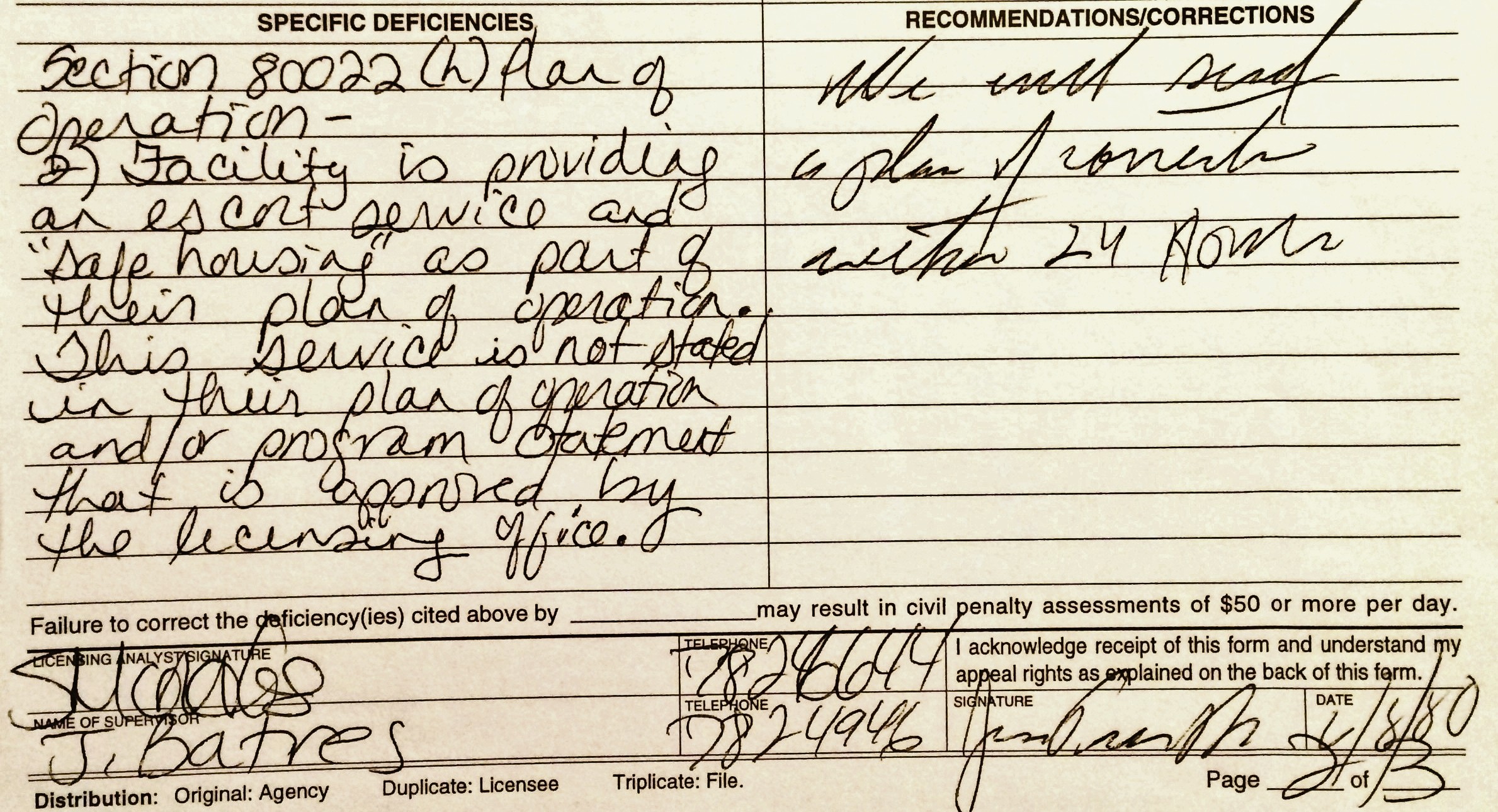 Part of a substantiated three-page complaint investigation report about ?employed staff of CEDU? taking residents to homes or hotels for ?care and supervision.?
Part of a substantiated three-page complaint investigation report about ?employed staff of CEDU? taking residents to homes or hotels for ?care and supervision.?
As best I can tell, California?s Department of Social Services didn?t consider CEDU a sleepaway school for depressed teens, or a Synanon spin-off, or ?a drug rehabilitation program,? as The Washington Post noted in October, 1983, a month before my birth. For the state, this for-profit, private-pay facility was a group home. And a disturbingly carceral one. Apparent within five minutes of public records research: bathroom strip-searches; incoming and outgoing mail read by staffers; ?limited phone calls, or sometimes no phone calls?; family visits ?disrupted by staff,? or visitations not allowed altogether.
CDSS?s Deputy Director of Public Affairs closely reviewed the novella-sized CEDU file prior to sending it. And yet, when we spoke, he magically knew nothing about the facility. Neither did two uncompassionate employees at the Children?s Residential Program Office. So I kept calling CDSS. In countless icy conversations with both Sacramento and Riverside, ?it was a long time ago? and ?I can?t speculate? were the best answers I could get.
Conveniently, when it comes to my old group home, CDSS is memory-deprived. And yet the Licensing Program Manager who runs the Riverside office, and helped oversee my Public Records Act request, was once a licensing analyst who inspected CEDU. Her name even appears in facility reports from the early 2000s.
Why did the state of California tolerate CEDU?s deranged self-policing until 2005 ?If CDSS knew about and substantiated child abuse accusations, why was CEDU?s license never suspended or revoked? Why weren?t all parents notified about CEDU?s nonstop violations?
If anyone at the agency could answer these questions ? and a thousand more ? it would be one of CEDU?s licensing analysts.
I made several attempts to start a dialogue, but she never responded. Instead, she forwarded my messages to a CDSS spokesman. ?We are not equipped to speak about a facility that has been closed for over 15 years,? he wrote.
The thing of it is, years ago, state inspectors interviewed CEDU?s adults and scanned their records, investigative enough to wonder, in jittery reports, ?what type of training do staff receive on how to conduct RAP sessions? or ?what constitutes Assaultive/Aggressive behaviors?? (Easy answer, bub. You were standing in it.) And yet within all their evaluations, these professionals failed to notice ? or write down ? some of the facility?s most troubling realities.
To start, along with Lake Arrowhead tourism, CEDU helped keep the mountain economy alive. Its closure was a community disaster. One example: it affected ?about 40 percent? of the town doctor?s practice, an admission made to the Mountain News in 2005. Why such a large percentage? Because this doctor ? a very undoctorly ?expert in the field of addiction,? as I remember him ? was also CEDU?s medical director.
(CEDU?s Northern Idaho programs helped drive a rural economy, too. According to the Bonners Ferry Herald, ?CEDU was the largest private employer in Boundary County.?)
Making matters worse and weirder, adults participated in CEDU?s communal anti-therapies. Counselors didn?t just oversee treatment but treated themselves.
CEDU hardly concealed this practice. In 1996 employment info, discovered via The Wayback Machine, a ?willingness to share personal and emotional growth experiences? is a fully capitalized ?REQUIREMENT.? Similarly, in a hagiographic blog post tribute to Mel Wasserman, CEDU?s founder, a well-indoctrinated staffer who ?held many positions? from the mid-seventies to 1990 wrote: ?a requirement for any new faculty member was full participation in the Cedu program of personal growth.?
If that?s not enough, in 2005, during CEDU?s initial closure, another loyalist wrote in ?CEDU Education ? ?Here Forever,?? a syrupy 2,500 word essay, ?[s]taff, like myself, had to perform before the school in the same way we asked the children to perform.?
And if this still sounds too gentle or ambiguous, a CEDU counselor ? a central figure at the California compound from the late 1980s until the early 2000s ? emailed me this recently:
we went thru the emotional growth rigors as the students?..we were also confronted in raps?.not always and some staff conned their way thro raps?but in general, we were treated the same.
In a further twist, the facility was partly staffed with former residents. (Really, what?s the point of a background check if the program is the background?) Out of the nine main counselors I remember, three had been teenagers ?rehabilitated? either at CEDU or at one of its clones. As expected, these adults ? all in their twenties to very early thirties ? ran the show.
The most powerful counselors, the ones who, again according to employment info, ?facilitate[d] emotional growth activities, including raps, propheets and workshops,? were called ?team leaders.? To become one, the first requirement was an ?in-depth understanding of CEDU Education philosophy.?
That ?philosophy,? carried out in secret, was unknown to most people in the real world. But the adults who crept into CEDU jobs ? not just team leaders but, from what I recall, the whole highly uncredentialed staff ? seemed guided by it.
What was the ?CEDU Education philosophy?? With a bit of internet digging, I located one of Mel Wasserman?s daughters and messaged her. (Guru Mel died in 2002, no longer a furniture-salesman but an empire-builder.) Maybe, I hoped, the founder?s daughter could explain the family philosophy. Maybe she could also clarify CEDU?s origins, and her father?s Synanon positions. Maybe ? at last ? someone could publicly admit the facility?s true name was ?Charles E. Dederich University.? How can survivors reconcile multi-decade institutional abuse if we?re not even sure about the institution?s name?
I corresponded off-the-record with Mel Wasserman?s daughter for weeks. However, upon learning this article would address child abuse, she opted to not answer my questions.
From Orgies to Brainwashing to Bad Food
I wish I had met the man who towered over CEDU. I?ve never even heard Mel Wasserman?s voice ? an extraordinary fact since he verbally provoked so many of us into screaming.
The closest I?ll get to Wasserman comes from a brash, disdainful op-ed he wrote in the San Bernardino Sun. It?s 1969, and Dear Leader Mel believes he is ?under attack by certain extremist groups in the San Bernardino area.? He rages about a ?witch hunt? and ?stupid and false accusations? against his CEDU family. Then he ?aim[s] several charges? at city council. ?I am sorry to see that elected representatives?are now involved in Joe McCarthy and Father Coughlin-like smear tactics,? Mel snorts.
To understand his wrath, I pulled an earlier article ? not penned by Mel. It seems a city councilman, Edward S. Wheeler Jr., had called for an investigation into CEDU. The recipient of ?many, many complaints,? from former residents and regular civilians, Wheeler ?urged the council to maintain a ?watchful stance? over the facility.? (A second councilman simply refers to CEDU as ?a shady operation.?)
As a result, Mel Wasserman decided to play the Synanon Game with city council. (I?m not being cute. In his hit piece, Wasserman sounds like Charles Dederich.) He indicts everyone, defends vigorously, feels he?s owed a ?public apology,? ?demand[s] that the San Bernardino City Council investigate the situation which allowed some of its members to smear Cedu Foundation, Inc.,? and, with great effectiveness, spends several paragraphs personally destroying Wheeler. Mel is absolutely convinced the anti-CEDU councilman is ?being used by a group of ?Little Old Ladies in Tennis Shoes.??
This diatribe was batshit enough to prompt a response in the same paper. The ?rebuttal,? however, didn?t come from Councilman Wheeler. Instead, it was a concerned citizen taking on Mel in the ?Voice of the People? section.
?[Wasserman] knows perfectly well that the ?extremist groups? and the ?Little Old Ladies in Tennis Shoes? making accustions [sic] against the Cedu Foundation are the parents of young people who are either in Cedu or have been attending some of the Cedu sessions,? this individual writes. ?If his foundation is so ?peachy,? then why all the complaints? I know for a fact that the police and sheriff departments have a large file of complaints by parents. There is a lot more going on than the public knows.?
The ?rebuttal? ends with a plea for a ?full public investigation with the parents and former inmates heard.?
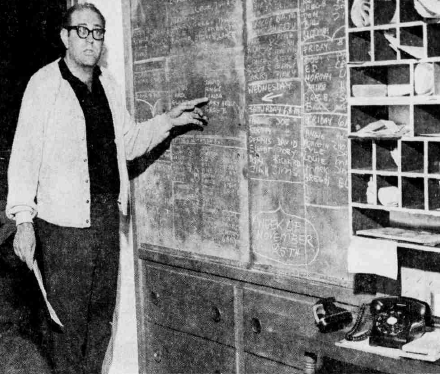 A photo of Mel Wasserman during a 1968 CEDU raid. ?The warrant was requested by District Attorney Byron C. Morton and issued by Riverside Municipal Judge E.M. Rich,? the San Bernardino Sun writes. ?Sheriff?s deputies arrived with other Riverside County officials at Cedu Ranch?.[t]hey had the sheriff?s department?s portable crime laboratory with them.?
A photo of Mel Wasserman during a 1968 CEDU raid. ?The warrant was requested by District Attorney Byron C. Morton and issued by Riverside Municipal Judge E.M. Rich,? the San Bernardino Sun writes. ?Sheriff?s deputies arrived with other Riverside County officials at Cedu Ranch?.[t]hey had the sheriff?s department?s portable crime laboratory with them.?
CEDU parents weren?t the most investigative bunch. (As a former inmate, I hope I can say this irrefutably.) Sure, the program instructed parents to assume their child?s complaint was a lie. But, more unnerving, CEDU understood these ?desperate? adults weren?t the type to then visit a public library?s microfilm reader.
So, reading fifty-year-old articles from CEDU?s infancy, I was surprised (and envious) to see parents ? and entire SoCal communities ? judiciously tracking the movements of this eccentric ?self help communal home.? (Or, if you prefer, this ?controversial home for social dropouts.?)
I wonder what my parents in 1999 would have thought about a 1969 San Bernardino Sun story titled: ?Critics Assert Cedu Destroying Teenagers.? Its catchier subheadline: ?Allegations Range From Orgies To Brainwashing to Bad Food.? (Sums up my entire experience thirty years later.)
Beyond a few sixtiesish bits and some dueling conspiracies, this is a digestible cult tale: a single-mother cautiously allows her seventeen-year-old daughter to undergo CEDU?s ?sensitivity sessions,? on condition that she attends college by autumn, then loses her completely to the program.
Bless this undaunted (and unmanipulable) mom. Even with her daughter incommunicado and CEDU?s ?refusal to let her see the girl,? she storms the facility. The daughter, found ?in a hypnotic state,? is ultimately released, but it takes threats of going ?to the authorities,? ignoring a ?letter of permission? to keep her CEDU-bound, and reminding staffers that, at seventeen, their new recruit is still underage.
According to the article, before a full rescue, the mother strong-armed her way into a couple of unmonitored visits. These CEDU jaunts yield blunt observations. ?After watching [residents] and listening to them for two hours,? the mother is quoted as saying, ?I told them there was not an individual thought among them, they all said the same thing and acted the same way and it was as if they were controlled by one brain.?
Twisting the knife deeper, she argues that Mel?s program accomplishes nothing ?except the kid is taken away from the family environment and is only ?cured? if he stays with Cedu for life.?
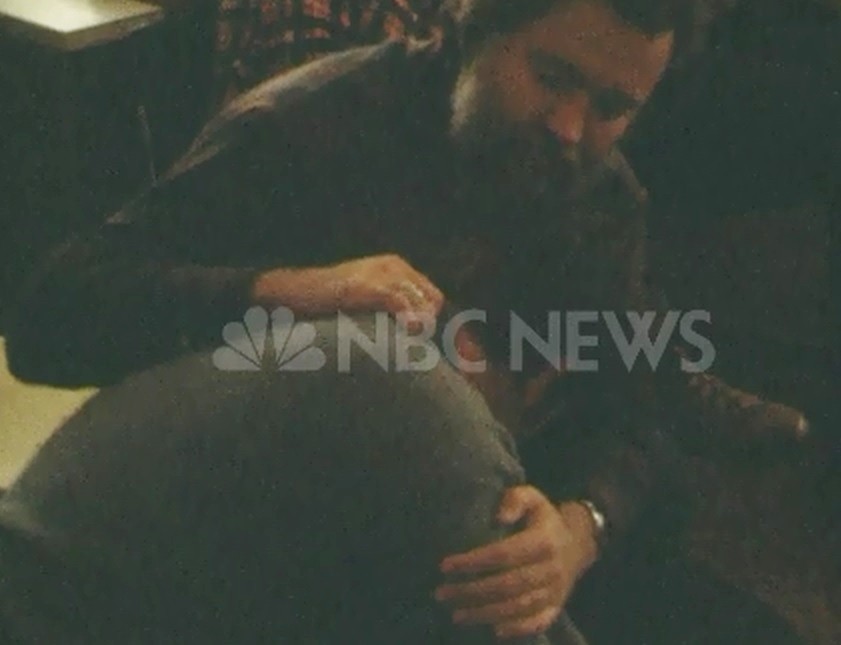 A CEDU staffer holds a resident after pounding pillows. Screenshot from a 1972 NBC News segment on CEDU.
A CEDU staffer holds a resident after pounding pillows. Screenshot from a 1972 NBC News segment on CEDU.
Another fairly typical cult story appeared in the same newspaper four months earlier. This piece highlights a couple?s futile effort to ?force Cedu to release their 18-year-old son.? Similarly, this local teen had become ?involved in the foundation?s ?sensitivity sessions,?? and stayed on as a permanent member of the CEDU family.
After an ?unfavorable court decision? (the boy ?testified that he was at Cedu of his own free will?), his distraught parents ?launched a letter writing campaign,? calling for a ?full-scale investigation of Cedu? along with a ?financial audit of the foundation?s books by an independent agency? and ?an examination of the qualifications of the staff.? Even more unrealistically, they also wanted ?stricter laws to regulate such foundations.?
In the words of their campaign, the parents would ?bring to light the plague? of CEDU. Wasserman?s program ?[m]isled many young people and adults, and if the truth comes to light, the Cedu Foundation will be eradicated in [San Bernardino County] as it was in Riverside County.?
?Eradicate? is a harsh word, but accurate. An extremely shrewd community rejected CEDU. Consequently, the San Bernardino Sun reports, ?the foundation was forced to move from its Reche Canyon location? to Running Springs. Quite literally, CEDU fled to the mountains.
It wasn?t welcomed there either, but it took thirty-six years for that eradication.
It needs to be stressed: Riverside County?s problem with CEDU was darker than a ?get off my lawn? incompatibility. For example, according to a 1968 San Bernardino Sun piece, ?[u]niformed Riverside County?s sheriff?s deputies, a deputy district attorney and members of the county building and safety and health departments entered Cedu Ranch.?
Ostensibly, this was an investigation into code violations. But, really, it was a raid. Along with a search warrant, ?investigators?photographed dining and living facilities and tape recorded all that was said.? More dramatically, ?[t]hey had the sheriff?s department?s portable crime laboratory with them.? According to Mel Wasserman, a ?uniformed deputy? mentioned that ?the portable lab is used in the investigation of major felony crimes.?
I?m not sure what was retrieved, but the piece includes a photograph of Wasserman. He stands in front of a ?progress board? looking a bit like a schlubbier Philip Larkin.
This was the first picture I had ever seen of CEDU?s founder, and he?s holding a search warrant.
 CEDU?s ?raps and clans? structure described in 1971 program literature discovered in the California Social Welfare Archives.
CEDU?s ?raps and clans? structure described in 1971 program literature discovered in the California Social Welfare Archives.
I?d need another article, or twenty, just to comment on CEDU?s early media coverage. Even neutral profiles underscore Mel Wasserman?s total lack of training (oh, he may not ?have a degree in psychology, but he does show a deep understanding of people?) as well as CEDU?s burgeoning cultishness.
For instance, in a 1968 San Bernardino Sun profile, Mel Wasserman, then thirty-eight-years-old, is described as ?the head of the family, both in name and in the eyes of the family members.? With ages ranging from twelve to forty, members have a ?loyalty toward the family? and share Papa Mel?s entrepreneurialism. ?People at Cedu have a crusading zeal about what they are doing. In the next 10 years they hope to set up cedu houses throughout the nation.?
Another 1968 profile, published just two days later and headlined ?Professionals View Cedu Ranch With Reservations,? the same staff writer notices ?reformed drug users are extremely loyal to Cedu and now attack the drug scene with a missionary zeal.? She then connects this ?voluntary? ranch to a ?similar home? ? Synanon.
?What is the danger of these people becoming so dependent upon an artificial society they never leave to return to the real world of temptations?? the reporter asks, dancing around the cult issue.
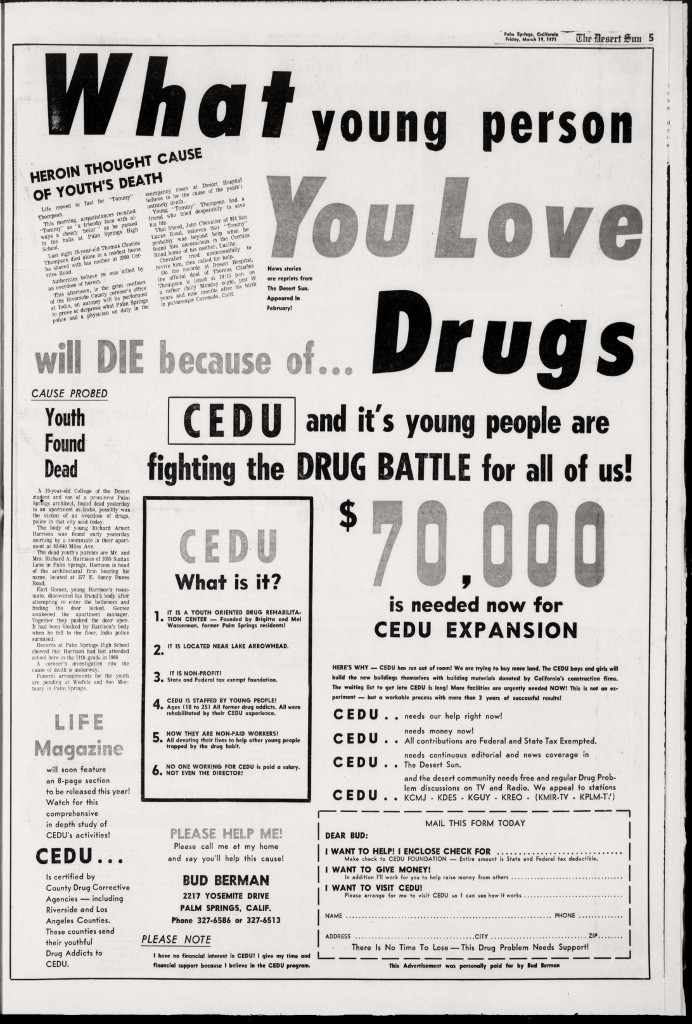 CEDU full-page ad from 1971.
CEDU full-page ad from 1971.
These polished 1960s CEDU reports are fascinating. But what?s gut-kicking are reader responses. For example, in 1969, another concerned citizen writing in the San Bernardino Sun?s ?Voice of the People? section articulates the dangers of ?marathon group therapy sessions? and ?sensitivity training.?
?[I]n the hands of persons not professionally trained?participants have been known to have suffered psychotic and neurotic reactions following sessions,? the commenter writes. ?The reason I am pointing this out is that I have been told that both marathon group therapy and sensitivity training are being used at Cedu Foundation in Running Springs. If this is the case, who at Cedu is qualified to carry on this type of treatment? My understanding is no one has these qualifications.?
I applaud this perceptive San Bernardino man, but he missed CEDU?s main selling point: it scarcely bothered with qualifications.
Perhaps the most unforgettable example is a full-page ad in the Desert Sun from 1971. ?What young person You Love will DIE because of?Drugs,? the ad asks, lacking a question mark. Then it responds to itself: ?CEDU and it?s [sic] young people are fighting the DRUG BATTLE for all of us!?
This one page eyesore, which absolutely looks like it was designed by a young person on drugs, is meant to scare readers into donations: CEDU is seeking $70,000 for an expansion.
Mel?s foundation is now fully capitalized, but so is half the advertisement. A box in the middle of the page announces that CEDU is a ?YOUTH ORIENTED DRUG REHABILITATION CENTER.? It goes on: ?CEDU IS STAFFED BY YOUNG PEOPLE! (ages 18?25) All former drug addicts. All were rehabilitated by their CEDU experience.?
And there you have it. What ought to be a serious concern ? residents blurring into employees ? has been turned into a hook.
The Premise of the School
Type the facility into Google and the second and third links lead you to a comprehensive website, ?Surviving Cedu,? masterfully assembled by the investigative journalist, and ex-resident, Liam Scheff. There?s a great deal of terrifying documentation, but the heart of this site is thirteen separate video clips. Stitched together, they create the only CEDU documentary I know to exist.
Filmed between 2007 and 2010, these no-budget clips (a survival-horror film, really) does everything this article can?t: distill all of CEDU?s sprawling abuses and bloody charlatanry and conditions in its camps. It?s an extraordinary accomplishment. A half-dozen ex-residents, including Liam Scheff, bravely recount their detainment ?15 to 20 years after leaving, graduating or escaping from this unique, troubling and isolated world.? (I don?t know these survivors, they?re all a bit older, but our experiences were essentially the same.) Scheff also interviews a longtime CEDU counselor; a professor of psychiatry and pediatrics, Dr. Nicki Bush; and the lawyer and cult expert, Paul Morantz.
For many, Paul Morantz is a folk hero. ?In 1977,? his website states, ?Morantz began a battle to expose Synanon.? As a result of this exposure ? and lawsuits ? Chuck Dederich (and his Imperial Marines) retaliated. ?On the afternoon of October, 10, 1978,? write the authors of Cults In Our Midst, ?Morantz went home, reached into his mailbox, and was bitten by a four-and-one-half-foot diamondback snake.? Morantz needed ?eleven vials of antivenom serum to pull him through.?
Thirty years later, the man who barely survived Synanon?s assassination attempt was featured in a documentary about CEDU talking about ?cults, thought reform and confession.?
Nicki Bush endured a different type of envenomation: she spent a summer at CEDU?s Rocky Mountain Academy, hired ?to do program evaluation in order to promote the school and sell the program.? Bush?s 2008 interview is similar to her prepared statement, three years earlier, at a congressional hearing on the dark doings inside private, unregulated residential facilities. This statement is harder to find than her on-camera interview, and worth quoting.
While at CEDU Idaho, she became aware of its ?unethical, harmful, and falsely marketed care,? Bush writes in the press brief. Instead of selling the program, she ?called several governing organizations from a campus phone and whispered hushed concerns to agency representatives.? Her worries went nowhere, and ?[e]ach day at this job brought new discomfort.? One discomfort was learning rap sessions were run by ?staff who had worked their way up the ranks from kitchen cook and had no formal schooling beyond their H.S. diploma.? Another discomfort:
For the most part, they were ?following directions? put forth by the ?emotional growth curriculum? taught by tenured staff and in staff manuals. One such therapeutic workshop manual read, ?When I say commence you will slap your partners (in the face) as hard as you can. Do not rip them off. No holding back.? Facilitators were instructed to place cotton in the mouth of any children who have braces so this does not leave an internal mark.
For me, one of the most complicated things about Scheff?s documentary is his interview with a counselor.
Dennis Dockstader worked at CEDU?s Running Springs campus from, according to his Facebook page, 1983?2005. (Since he allowed his full name in the CEDU documentary, I?m using it here.) During my time, Dockstader was one of two hippie counselors. Both were older, kindly, easygoing, generally unintimidating, but utterly powerless.
Dockstader?s entire interview is noteworthy, especially his bizarre employment backstory. His account of what happened, told with the same slow, dry voice and gently impish facial tics I remember from my childhood, should be summarized: Dockstader, the director of a nearby music camp, received a call from CEDU?s administrator about teaching ?Jazzercise and guitar.? ?Clearly you don?t want me,? he remembers saying. Aware that CEDU was ?very intense,? though, he asked about staff ?burnout.? (??cause I was kind of wondering that with my own operation,? Dockstader acknowledges.)
He doesn?t tell us what the administrator said, but after turning down the Jazzercise and guitar opportunity, CEDU sent him an application with four questions. ?How do you feel about corporal punishment in the schools?? was the first. ?And the second one,? Dockstader says with an amused smile, ?was an equally big question.? (He doesn?t reveal it, or the other two.)
Realizing it would ?take days? to answer just one question, Dockstader ?set [the application] aside.? ?I never sent the thing back,? he admits. Still, CEDU called again to schedule a job interview. It?s unclear why he accepted, but Dockstader recalls his interview with twinkly bewilderment. At the time, the facility was run by a former resident. ?I don?t know if he actually even ever offered me a job. It was, like, ?well, can you work for us???
?One of the strangest situations I?ve ever had,? Dockstader says, sounding like a man who?s had a lot of strange situations.
With his hip, melancholic demeanor, it?s easy to mistake this gray-haired, gray-bearded interviewee as a voice of reason. But Dennis Dockstader was a CEDU counselor for over two decades. Worse still, in the documentary, he doesn?t denounce the facility:
There was an understanding that the school was about challenging, you know. It wasn?t just to have smooth times. Like, you had to stir the person up, you know. There was some kind of underlying understanding that that?s valuable and we need to do this, right. So, when things get too easy, that?s of no value. That?s just a vacation. So, let?s keep that person stirred up.
The segment cuts to an ex-resident discussing the psychological trauma of attack therapy, then returns to Dockstader. ?I mean, that?s the premise of the school,? he says flatly. ?You know, like, stir things up. Don?t let it get too easy. Don?t let it get too comfortable.?
CEDU wasn?t a ?school,? but a movement. Even at fifteen-years-old, I had read enough dystopian novels to recognize that. But, otherwise, this old hippie on a faraway mountain is precisely correct.
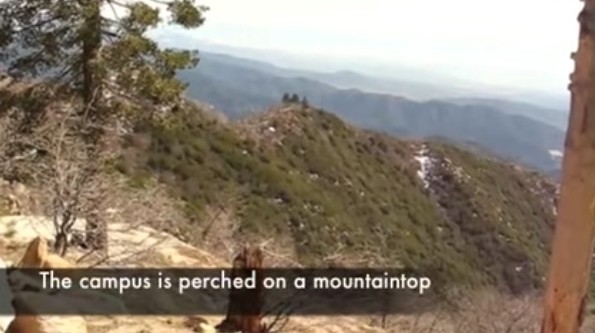 Screenshot from ?Surviving Cedu.?
Screenshot from ?Surviving Cedu.?
The trouble is, my parents ? most parents ? didn?t know CEDU?s premise. They didn?t know, for example, that rap sessions kept residents day-to-day decimated, always on the verge of breakdown. And they didn?t know that, to get us entirely stripped away, CEDU imposed grueling ?propheets? and multi-day workshops. Counselors forbade us from discussing our experiences. We emerged from these shadowy seminars in group-euphoria and complied.
?The Propheets,? Liam Scheff wrote, were ?overnight, all-night intensive, interpersonal, no-boundary, no-warning, no-escape adventures in 60s and 70s home-grown self-help psychodrama.? Workshops were similar psychodramas, but with ramped-up savagery and incoherence and theatricality.
CEDU?s self-improvement ceremonies were mostly kept quiet, but I did find a well-buried reference in a 1968 San Bernardino Sun article: ?Periodically, the family holds propheets, another manufactured name given to marathon encounter groups.? As for what happens in these ?48-hour? propheets? The staff writer only says ?all facades and all disguises are torn away.?
 After undergoing CEDU propheets and workshops, forced participants would receive cutesy congratulatory notes from other residents.
After undergoing CEDU propheets and workshops, forced participants would receive cutesy congratulatory notes from other residents.
A longer propheet reference can be found in a 1973 CEDU brochure. It?s unclear whether this grim little booklet was intended for the greater public or functioned as in-house reading material. Nevertheless, at times, the language is uncharacteristically honest. For example: ?The Propheet is a ritualistic experience at Cedu.?
I discovered the ?73 brochure on a private Facebook group, ?Friends Of CEDU Photo Library.? (Also called ?The Friends of CEDU.?) As I understand it, this group ? with over six hundred members ? is the largest online community for the program?s residents and staffers. And it?s radically pro CEDU.
Vigorously bowdlerized ? the group rules suggest there is ?no censorship? while also underscoring ?negative? posts will be removed ? the ?Friends Of CEDU Photo Library? mostly archives program ephemera and personal photos of smiling residents.
Strange, then, that no one is smiling in the ?73 brochure. Instead, its pages are filled with shadowy black-and-white photographs: a balding adult with a thick mustache authoritatively watching a screaming boy?s blurry profile; faceless teens in a group hug; against a black background, the head of a scolding, disembodied adolescent running his anger straight out at us ? mouth open, teeth bared. Add some snakes, and it?s the CEDU knock-off of Caravaggio?s ?Medusa.?
 1970s CEDU literature.
1970s CEDU literature.
And what about these ?ritualistic? propheets? The brochure says they run ?approximately 20 hours? and ?[m]usic is used extensively.? Reading like a memo promoting enhanced interrogation techniques, the brochure goes on:
By the time the Propheet commences, participants are emotionally ?wired up.? All this time preparation, plus the plain wearing down over the long period of time, almost invariably functions to break down defenses.
Spread over the two-year term, propheets and workshops were the ?courses? in CEDU?s emotional growth curriculum. I was a forced participant in nearly all of them. And while these marathon encounter groups are still utterly obscure to me, I do know that ?the liberation of the child within? was, reportedly, CEDU?s overall endeavor. And the most effective form of liberation came via physical and mental collapses.
The child within couldn?t find another way out.
Emotional CPR
In 2002, Forbes published a 3,000 word article about CEDU and the ?emotional growth? business. I don?t remember how I first came across this piece, but it was so inaccurate and insulting ? loaded with all the comforting lies my hoodwinked parents believed ? it provided yet another reason to stay silent. Even its salacious title, ?When Rich Kids Go Bad,? was a slap in the face. I was a bad kid? I was a rich one? My mother was a public elementary school teacher; my father sold seasonal accessories.
?When Rich Kids Go Bad? was some of CEDU?s biggest, and most accessible, media coverage. Unfortunately, the article?s author, Erika Brown, spent her reporting career not covering cultic treatment facilities, and her wholesome article often reads like an extended CEDU brochure: ?Cushy couches and stone fireplaces warm up classrooms.? ?Counselors impart lessons from Kahlil Gibran?s The Prophet.? When she visits, ?a dozen kids gather at a piano to sing John Lennon?s ?Imagine.?? A male resident ?could have graduated?but asked to stay on a little longer.? A female resident?s ?gothic scowl has yielded to a soft smile.? ?Instead of shouting, she calmly expresses herself in group therapy.? (Hold on, wasn?t group therapy about shouting so forcefully our faces would be flecked with broken blood vessels?)
Oh, sure, these rich, bad scamps ?rebel in whatever ways they can.? But, as Brown asserts, ?[b]reak a rule and they must chop wood or dig a stump.?
Or dig your own grave. Or spend a week sitting alone in the dining hall ? banned from smiling and laughing and singing and communicating with fellow residents. (Solitary confinement in front of others.) I also learned of newer cruelties from CDSS?s evaluation reports. For instance, several licensing program analysts questioning kitchen staff about ?an area of concern regarding food services? discovered one resident ?was not provided appropriate meals for at least three days. This is reportedly a usual practice for any children who do not comply with the facility program.?
You?d think finding a half-starved child ? punished for ?not wanting to participate with school or other activities? ? in an empty, ?previously undisclosed room? would promptly close a group home, but CEDU staggered on for another year.
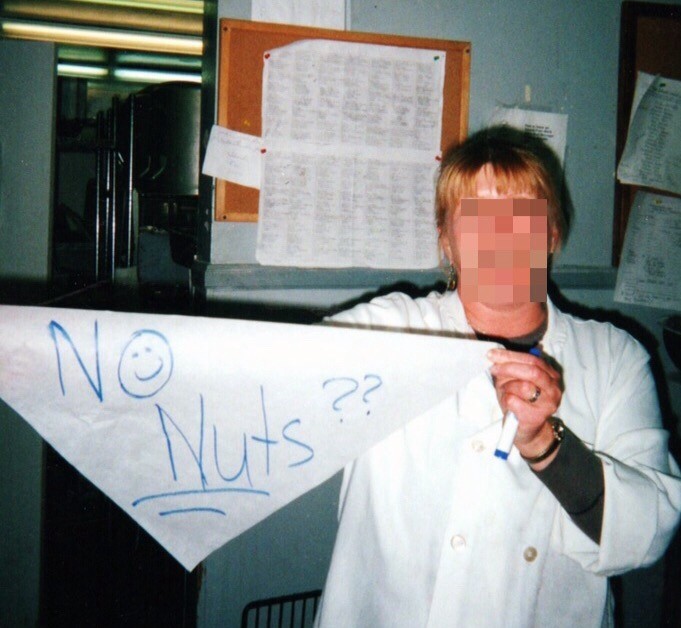 A CEDU kitchen staff member photographed by the author.
A CEDU kitchen staff member photographed by the author.
Although Forbes claimed to have ?spent months interviewing kids, counselors, parents, psychiatrists and medical researchers,? no counselors are quoted. But their presence ? and spin ? is everywhere. ?Rather than boot-camp-style punishment,? Brown confidently writes, ?the program practices emotional CPR.?
I have no idea what ?emotional CPR? is. But in 2002, the same year Forbes put out this dreck, a CDSS report shows five CEDU staffers had ?no proof in file of first aid training or certificate? and nine others had an ?expired CPR/First Aid card.?
While on the subject of resuscitation, on two occasions I remember wearing a Holter monitor. I?m still not sure why I had heart rhythm problems? they only occurred at CEDU ? but I imagine a psychologically shattered asthmatic doing boot-camp workouts six thousand feet above sea level could be one reason. Our fitness regimen was overseen by an ex-marine (and recovering alcoholic) who?d glower at me when I struggled to breathe. My asthma, he thought, was an excuse to not participate. He was right.
I also remember anaphylaxis from consuming CEDU food, and being rushed nearly twelve miles to the community hospital. Among the few camp photos I?ve saved, one is a grinning but haggard cook holding up a handwritten note that says: ?No Nuts.?
The O has been turned into a smiley face.
?When Rich Kids Go Bad? is still up on Forbes?s website. (And cross-posted on ABC News?s.) It?s easy to focus on the article?s endless errors. More problematic, though, is what?s unmentioned. One example: Brown writes about a ?CEDU protocol of greeting counselors with hugs.? I don?t remember the daily hugging. I do, however, remember the nightly ?smooshing.? Before bedtime, boys, girls, and counselors collapsed together in the Walter Huston Lodge and embraced. ?Mandatory or forced adult/teen and teen/teen cuddling,? is how Liam Scheff described this wildly perverse CEDU protocol.
I can?t think coherently about smooshing, so let me describe an old photo posted on a Flickr account: a male resident, maybe fifteen-years-old, is sitting in one of those ?cushy couches? cradling a male counselor. The boy stares directly at the camera with what I hope is a forced smile. His arms are reaching down to the counselor?s abdomen. The counselor, in his thirties, is leaning back between the boy?s legs with one hand languidly holding the boy?s bicep. They look like a happy couple on a NAMBLA retreat. The counselor is resting his head on the boy?s shoulder. His hair is brushing against the boy?s cheek. He seems weaselly and relaxed, but dazed-looking ? like he might reprimand the photographer for taking this picture, or he might ask for more.
(FYI, this counselor, almost a decade later, would perform my cavity search.)
 A teen resident smooshing with an adult counselor. Photograph: Courtesy of ?Johnny Propheet,? CEDU resident from 1989?1990.
A teen resident smooshing with an adult counselor. Photograph: Courtesy of ?Johnny Propheet,? CEDU resident from 1989?1990.
Everyone participated in smooshing. The person tearing you to pieces during the afternoon?s ?group therapy? might have a chin on your trousers during the nighttime cuddle. This ?forced, no-boundaries, and often inappropriate affection?was considered expected behavior,? a wiki entry on CEDU lingo and activities explains.
In Liam Scheff?s documentary, the CEDU counselor, Dennis Dockstader, recalls bringing a civilian to campus once ?to play some music.? Unfortunately, he hadn?t ?prepped? this musician beforehand, and she saw a lodge in full smoosh. ?And we leave, we get back in the car,? Dockstader remembers, ?and she says ?can I ask you a question? Are they encouraged to investigate their sexuality while they?re here???
You can hear Liam Scheff laugh off-camera, and Dockstader smiles broadly. But this is only funny ? if that?s the word ? because CEDU was a vehemently sexless culture. Kissing another resident was forbidden. Thinking about kissing another resident was forbidden. But plunging a kid into a clothed orgy?
Well, that was compulsory.
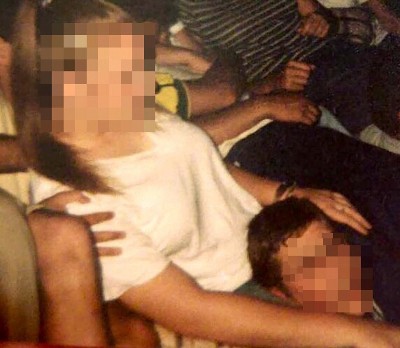 Male and female residents in a light smoosh.
Male and female residents in a light smoosh.
Self-Management Strategies
I know their answer, but I asked my parents again why, eight months prior to ?graduation,? they withdrew me from CEDU. ?It lost all credibility,? my mother said. I pressed her for specifics but it?s impossible to get the facts straight. Maybe, my mother thought, it was our lack of communication.
My father ? often half-hidden in these interrogations ? added another possibility: Dr. A, the psychiatrist who originally misdiagnosed me, had expressed some alarm about CEDU to them. Dr. A was about to go full-time at Eli Lilly, yet, for whatever reason, he continued prescribing my pills from afar, even increasing dosages. (Consider this: my parents in Illinois paid a pharmacologist I never saw to supervise my medications ? Klonopin and Zoloft ? at a California treatment facility.)
So, maybe, a second-rate doctor employed by a pharmaceutical company helped remove me from CEDU, a poor-quality program run by a corporation. Then again, my parents claim to have no memory of Dr. A?s exact concerns.
Here?s what I remember: had I completed CEDU, I would have been thrust back into public high school several months into my junior year. Coldly addressing this practical problem was easier than sobbing about unsayable ?therapies.?
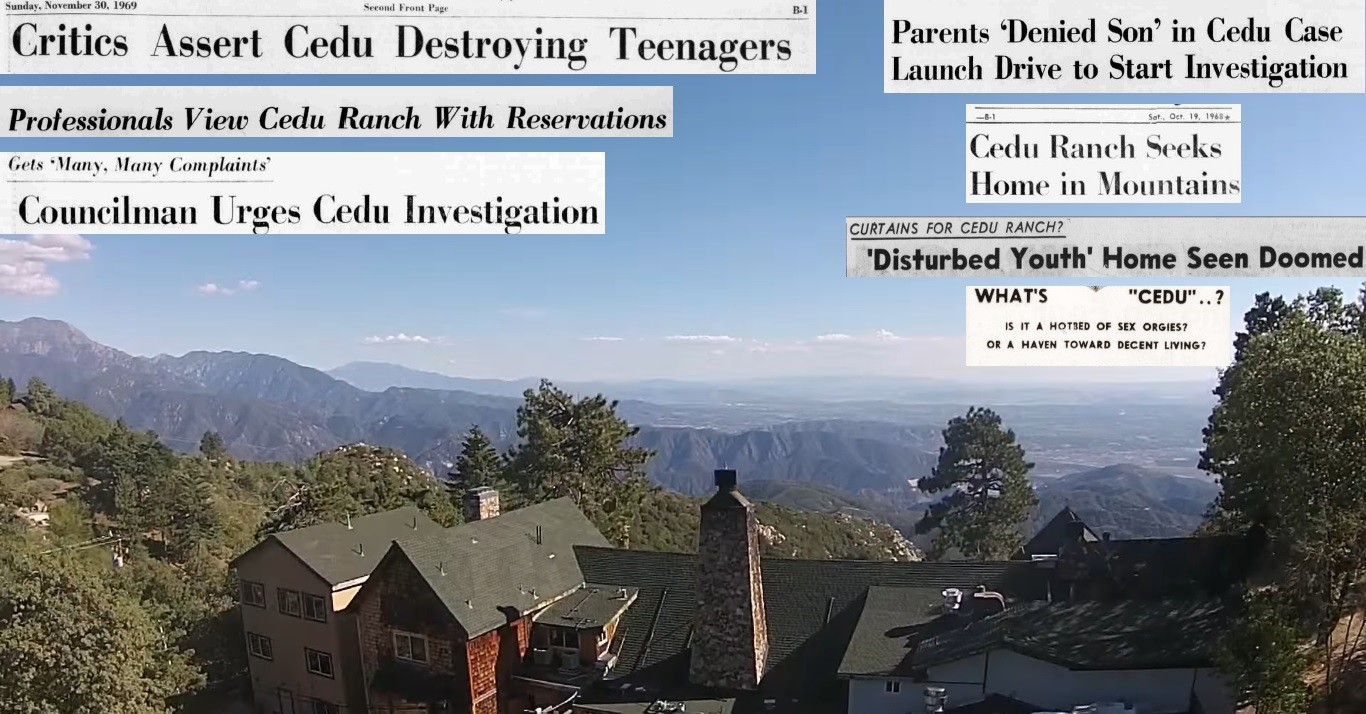 The house and the headlines.
The house and the headlines.
The best way to leave CEDU was how it had been entered: immediately and without much warning. My parents did themselves no favors by informing the facility (and me) of my commutation a couple months before I left. In response, my parents received an onslaught of irritated, disapproving phone calls from, they said, CEDU?s executive director, our family liaison, and a team leader. (It seems communication with the program started after threatening to remove someone from it.)
CEDU?s main diagnosis? I was troubled because of my parents and their terrible decisions. If I left early, I?d immediately return to misbehavior. The full two-year program was the only option for a healthy family reunification. CEDU pleaded and pushed, but my parents were undeterred.
The moment I returned to Illinois, all CEDU discussions stopped. It was a mistake, a waste of money. In lieu of, say, postcult adjustment or deprogramming, I worked at an outdoor music festival, standing in a crowded lot selling parking passes.
As a returnee, one of my first acts of independence was to quit Zoloft. Recognizing myself again, I tried tapering off Klonopin, but couldn?t. It takes weeks to develop a dependency. I had been downing high doses since eighth grade.
While commonly understood now, in the early 2000s, it seemed Klonopin addiction was only seriously addressed by a handful of astute physicians and Stevie Nicks. Here I was lucky: my monstrous benzo withdrawal was overseen by a neurologist. (He was tasked with preventing seizures.) Because every small dosage reduction was followed by a flood of symptoms, I started a lengthy home detox the summer after eleventh grade. Not including post-acute-withdrawal syndrome, it took seven months to get off Klonopin.
I?ve been med-free since late adolescence. But I?ve never recovered from the fact that, while at CEDU, I was chemically dependent in a facility ?treating? chemical dependency.
Dark and perplexing as that time was, I thrived back at public school. So, it?s completely astonishing that, toward the end of junior year, my advisor thought I had outgrown high school. I met early graduation requirements because CEDU had year-round classes. I agreed to academic acceleration, but I knew it wasn?t offered because of my maturity or intelligence. It was because of my CEDU transcript.
For an unknown reason, my mother shredded nearly every scrap of CEDU info except this transcript. Let?s inspect it.
On paper, CEDU?s quarterly report cards almost look like a normal high school?s. Each one includes course titles ? only four or five classes per quarter ? teachers? name, final grades, units, and overall GPA. No comments. If anything lightly stands out, it?s a pass/fail class taught by unnamed ?staff? listed in every report card. Using CEDU?s brochure language, this repeated class is called ?Peer Counseling.?
Those are rap sessions. Children received course credit for attack therapy.
(Wondering how these credits were reconfigured, I obtained my official high school transcript. What I learned? Sixteen months of the Synanon Game transferred over as ?Self-Management Strategies.?)
The problem isn?t one CEDU class, but all of them. For example, my spring report card lists Peer Counseling, Practical Math, Biology, and something called ?Work Ethics.? Math and biology were taught by a counselor; work ethics was taught by a team leader. Since both men were only referred to as ?teachers? in CEDU?s report card, who would?ve suspected their real positions?
CEDU?s math and biology classes have either vanished from my memory, or they never occurred. But I remember this counselor handing me lemon slices during a propheet. I received these slices to help soothe vocal strain from inexhaustible screaming. Elsewhere in that propheet, or maybe another one, I recall him massaging my back and pretending to be my father.
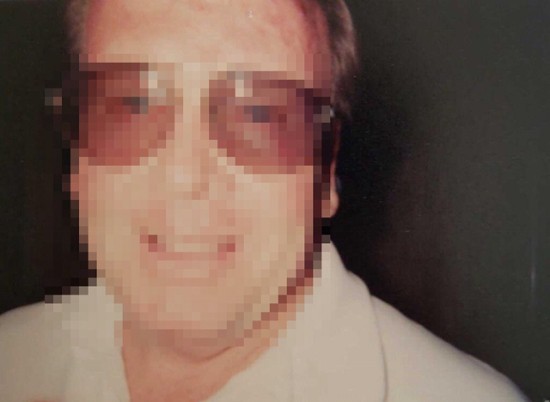 The author?s math and biology teacher at CEDU.
The author?s math and biology teacher at CEDU.
?Work ethics,? another long-forgotten CEDU class, preposterously transferred over as a ?life skills? class and a ?career internship.? A small joke for many reasons. One is that my instructor had as many life skills as a billy club and his career was exclusively linked to CEDU.
A violent young offender sent to CEDU Idaho in the 1980s, this team leader ? let?s call him ?Welz? ? was made worse (or made free) by its aimless experiment with confrontation. A proud alumnus, in his early twenties, Welz fled civilization to work for the California mothership. The year I arrived, to all appearances, Welz was unofficially running the facility ? a tall, muscular despot quick to provoke, or punish, or grind you up, or share hideous tales of his pre-CEDU assaults with a kind of bro-y, competitive relish. My parents met him once, very briefly, and could only describe him as ?mean.?
I haven?t communicated with Welz in eighteen years. My only connection to this humorless, pedantic, unstoppably dangerous man is through a doctored transcript. Reading it, I see a teacher who gave me ?A? grades in my mid-teens, and I remember a team leader who gave me recurring, sob-in-your-sleep nightmares until my mid-twenties.
In late 2007, just two years after CEDU?s closure, the old bruiser was facing charges for assault with a deadly weapon ? and possessing a generally prohibited one ? battery, and trespassing. Court records reveal that, in addition to spending thirty days in a San Bernardino county jail and thirty-six months probation, he had to undergo sixteen weeks of anger management treatment.
A rage-filled staffer who once facilitated CEDU?s incessant ?anger work,? and underwent it as a juvenile, was eventually sentenced to an anger management program.
This, in my view, is the legacy of CEDU?s emotional growth curriculum.
A Softer Kid
From the late 1960s until the first decade of the twenty-first century, CEDU absorbed (and encouraged) serial attackers just like Welz the Team Leader.
Who, then, is the worst villain in this story? Is it the entire CEDU Family of Services? ?Within moments of driving onto the campus, my new home for the summer,? Nicki Bush writes in her prepared statement, ?it became apparent that the world of treatment I have known would not apply to the children suffering in these facilities.?
From at least 1993 to 2005, California?s Department of Social Services knew children were suffering in the Running Springs facility. So, is the state the chief villain? What about parents? I asked my mother if she is responsible for the torture of her son. ?I don?t know about the torture part,? she said, ?but we are responsible.?
I suspect that?s the current attitude of many ex-residents? parents. But what is the attitude of ex-staffers?
In September 2017, I tracked down CEDU?s former executive director now working at a Catholic, all-women?s college in the Midwest. Ostensibly, I was fact-checking a curious allegation found in a 1998 Spokesman-Review piece ? that ?the schools? counselors are paid based on how long they keep students enrolled? ? and wanted her recollections. Once I had those, I wanted to discuss CEDU?s hiring policies. And then I wanted belated justice.
I didn?t expect a reply to my email, but one arrived, almost hilariously, on World Mental Health Day. She refuted the allegation and asked why I was writing about a facility ?closed for over 15 years.? (Wrong number, but never mind.) I wrote back, defending my article and seeking a public apology to survivors.
My request, however, ended our correspondence.
I keep thinking about the executive director?s one curt, self-protective email to me. ?Why bother writing about a closed facility?? is a question I heard while researching and pitching a CEDU long read. This flippant line mostly came from state agencies and magazine editors. CEDU, little-known and stone dead, just wasn?t a pressing issue.
It should be. Two of CEDU?s Idaho facilities ? Boulder Creek Academy and Northwest Academy ? were purchased by Universal Health Services, ?America?s largest provider of inpatient behavioral health care,? and reopened.
Predictably, this Fortune 500 company doesn?t run its properties with compassion. Abuses at UHS-owned facilities are so innumerable, the Service Employees International Union created a vast website, UHS Behind Closed Doors, to document them.
As CEDU proved with the Brown Schools, a self-help cult can hide ? and flourish ? under a corrupt parent company. For example, I noticed Boulder Creek?s 2018 online application features a ?student? picture from old CEDU brochures. Less sloppy, but just as shameless, buried in both facilities? enrollment releases is an ?agreement for additional emergency services? to a family company called ?Bill Lane & Associates.?
Bill Lane was CEDU?s president. And half of his ?leadership team? once worked at CEDU, too.
After seeing Lane?s name ? and aware of his long history at Synanon ? I contacted Boulder Creek Academy?s and Northwest Academy?s shared admission counselor. Quoting from the agreement, I asked why Bill Lane oversees services ?including but not limited to urgent transfers, crisis interventions and searching for runaways.? She did not respond to a request for comment. (Incidentally, this admissions counselor began working at the program in 1999. She had a Universal Health Services email address, but we both entered CEDU the same year.)
How many former CEDU or Synanon staffers are currently involved at these Idaho ?Academies?? Are children stripped of their rights? Are they reduced to silence among their parents and reduced to screaming at ?school?? Do they smoosh? Do they undergo propheets? Are locals plucked off the street and hired as counselors? I sent these questions ? far more diplomatically ? to others at Boulder Creek Academy and Northwest Academy. I also contacted Universal Health Services. No one responded.
 CEDU in 2002 and Boulder Creek Academy in 2018.
CEDU in 2002 and Boulder Creek Academy in 2018.
With a ?no media? policy on all sides ? including UHS?s own media relations people ?I also emailed Bill Lane. Could he explain his involvement? How often is his company called in for emergency services? And, given his Synanite status, what was Charles Dederich?s and Mel Wasserman?s relationship? Would he talk about the Synanon-CEDU connection?
Lane replied, requesting a phone call. I obliged, but he didn?t answer his phone. I left a voicemail. He never called back, or responded to additional emails.
Then, in late spring, Bill Lane surfaced on a BlogTalkRadio show. The topic: ?From Synanon to CEDU.? Lon Woodbury, CEDU?s former Admissions Director and one of its loudest online propagandists, was Lane?s interviewer. (According to a 1997 Spokesman-Review piece, Woodbury not only worked at a ?pricey, private school for troubled teens? but was ?chairman of the county Republican Party.?)
For fifteen minutes, these chummy old colleagues, both expert media manipulators, spun my questions into something like a Hannity/Trump performance. The attempt to discredit my article was underway before I had even found a publication for it.
I never met Bill Lane or Lon Woodbury, but I enjoyed hearing their voices. Woodbury?s is what you?d expect from a ?Native Idahoan? who likes to fish and kayak and publish an extreme newsletter about ?troubled? teenagers. Bill Lane?s voice is all street-tough Brooklynese. Throughout his interview, Lane sounds like he?s doing a dinner-jacketed Mafioso routine.
In his account, ?Synanon was the drug rehab, and one of the best known.? Joining it, Lane beams, ?was the best thing I ever did.? (He?s still close with other members, kvelling to Woodbury about his many Synanite ?colleagues and friends.?)
After it cured his heroin addiction, Lane stayed on living at Synanon. He also proudly worked for the program, playing various roles crucial to Synanon?s success.
(A 1971 New York Times article profiles Lane, a star Synanite, recruiting young addicts. The piece also points out that Synanon ?has its share of ardent defenders, but critics charge that it is cultish, anti intellectual and unprofessional.?)
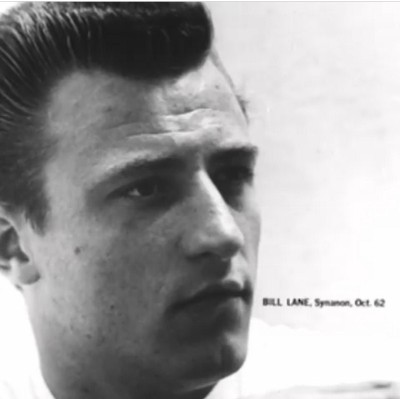 The face of Synanon. Lane would publicly defend the program until his death in 2019.
The face of Synanon. Lane would publicly defend the program until his death in 2019.
Speaking with Lon Woodbury, in Lane?s interpretation, Charles Dederich was a liberal visionary to be applauded. ?He wanted to work with everybody: he wanted to work with drunks, he wanted to work with drug addicts, he wanted to work with the gay.? Synanon?s brutal practices are shrugged off. ?Well, they were desperate,? Woodbury says, ??cause nobody was helping these kids.?
Both men do bring up Synanon?s ?cultishness? ? for instance, Lane?s son was born in the program to be raised by its in-house ?school? ? but that also gets disregarded. Ultimately, it?s Lane?s wife who can no longer tolerate her home. ?She forced my hand and said, ?listen, I?m leaving, I?m taking our son, I can?t live here? blah blah blah.?
And so, after twelve years at Synanon, Lane departed for CEDU. But this was no great change for the devout Synanite.
Lane and Woodbury never mention CEDU?s cultishness. Predictably, both men have nothing but golden recollections. ?You know,? Lane says, ?CEDU, in its own right, became, like, the school.? And earlier: ?we did things that were very, very, very unconventional but were very, very successful.?
Lane put thirty-two years into CEDU, but the only serious program development he acknowledges is its switch from a non-profit organization to a private-pay facility. In Lane?s words, Mel Wasserman ?wanted to start working with, I guess I could say, a softer kid.?
Woodbury nervously admits CEDU is closed. No reason is given. But it ?made a big difference in private treatment programs,? he quickly adds. When Lane speaks, CEDU occasionally goes present-tense. Worse, it is interchangeable with Synanon. For example, ?The Trip,? Synanon?s large group awareness training, ?are propheets now.?
As someone who has spent almost twenty years confused and paralyzed by propheets, it?s this slip I find most fascinating.
Lon Woodbury is planning more ?short interviews? with Bill Lane and other ?innovative leaders? from CEDU-like programs. And in addition to his radio show, he is still spreading the idea that CEDU was a noble and legitimate school on his ?Woodbury Reports? website. For years, he has publicly flaunted a program that should have ruined his reputation.
And CEDU?s long record of abuses? By the mid-eighties, the era Woodbury arrived, ?[s]haming, humiliation and punishment were no longer endorsed by the school,? he falsely writes in a rhapsodic nine-part retrospective essay posted in 2018. Woodbury continues with his misinformation:
of course many of the students thought being made verbally accountable for their actions was abusive, and of course rogue staff from time to time would lapse into those negative and harmful practices. However, getting to the root of self-destructive attitudes often requires intensive emotional and individual intervention which can be very scary to students. ?Getting honest? was a basis of their approach and that was the root of resistance.
I didn?t resist CEDU, I assure you, because I feared honesty.
With CEDU insufficiently exposed (and never receiving national outrage), its former employees and residents share their perspectives to very small, like-minded audiences. The fact is, in 2018, CEDU is still an us-versus-them family fight.
It?s a fight we soft kids are losing. Ex-staffers like Uncle Lon and Uncle Bill aren?t just a couple of ignorable, but self-satisfied, right-wing activists; they are competent businessmen still propping up the ?Troubled Teen Industry.? Woodbury, according to his Twitter bio, is an ?Educational Consultant for Parents of Teens with Problems? and Lane runs an ?Adolescent Transport Services? company.
Towards the end of their little chat, Lane makes a devastating claim: he has ?close to a hundred agents? and his company ?transport[s] everyday of the week to every program in the country.?
I wonder: how many of Bill Lane?s agents wake terrified teenagers at, say, four A.M. and transport them to programs Lon Woodbury recommended to their parents?
Maybe an ?innovative leader? can ask that question in Woodbury?s next radio interview.
I wish Bill Lane had talked to me. One of the great failures in this tedious memoirette ? and in my life ? is not understanding CEDU?s real connection to Synanon. I don?t buy the ?spin-off? stuff. Perhaps CEDU was more like Synanon?s showroom.
Think about it: Charles Dederich, a vengeful, cigar-chomping man obsessed with absolute leadership and flock loyalty, watched Mel Wasserman, a ?big supporter of Synanon,? create a rehab and commune hybrid aimed at young adults and adolescents ? ages Dederich pursued, too. Wasserman employed powerful Synanon members, and his program?s methods ? and name ?were Dederich?s. Hell, CEDU even moved closer to Synanon?s Santa Monica headquarters as it evolved. And, perhaps most offensive, this little project was profitable.
Charles Dederich demanded human ears in glasses of alcohol for lesser betrayals. Why did he tolerate CEDU?
?Tolerate? may be too light a word. In the raw, seventy-four minute version of Liam Scheff?s interview with Paul Morantz, filmed years ago but surfacing on YouTube in 2017, Scheff, in an off-camera aside, quotes a prominent Synanite as saying CEDU ?was well-regarded inside of Synanon.?
Was CEDU ?well-regarded? simply because Guru Mel kicked up to Guru Chuck? Is there any evidence that, in exchange for payoffs, Synanon let its spin-offs exist? I put the question to Paul Morantz, arguably the finest Synanon authority.
?No,? Morantz replied.
In our short correspondence, Paul Morantz told me that ?Dederich was aware of [Synanon clones]. Those knowledgeable saw them all as threats.?
Except for CEDU. That one was well-regarded. Even Paul Morantz couldn?t explain why.
It May Not Have Been For Everyone
I?m finishing this piece nineteen years after first stepping into Running Springs. To quote Randy VanWarmer?s 1979 soft rock hit, ?Just When I Needed You Most? ? one of CEDU?s repeatedly-played interrogation songs ? ?where I?ll find comfort, God knows.?
I haven?t found comfort investigating a facility whose entire ?premise? was to stir children up. And I won?t find comfort publicly revealing myself as one of those children. As Paul Morantz says in the CEDU documentary: ?not only by you confessing are you giving yourself to the group, but the group now has intense knowledge of you ? and they can use that information.?
You now have intense knowledge of me. But I?ve failed horribly at understanding CEDU. So, in search of a better note to end on, I returned to a former official I had unsuccessfully attempted to interview earlier in winter and pleaded for assistance. This individual preferred not to be named but allowed a quote, worried my article would misrepresent the CEDU family and its contributions.
?CEDU,? she declared to me, ?was a very intensive and confronting program born out of the 60s, a time of great need, and a very effective style in snapping people out of their self-destructive ways. The style was life-saving for most who came to us. It may not have been for everyone.?
So far as I know, that last bit ? ? [i]t may not have been for everyone? ? is the closest CEDU has come to a public apology.
I never met my lectury correspondent; she was merely on a short list of CEDU cognoscenti and higher-ups to contact. Our thirty plus messages were confidential. What I can say is this: at a stroke, she dismissed thousands of survivors? complex trauma.
I?ll say this, too: her quote quickly falls apart with a few Google searches and mouse-clicks. But presenting evidence was useless. This former official was, I realized, what the writer Andrew O?Hagan said about Julian Assange: ?glued together with lies and denials but?obsessed with a moral programme that makes everyone else face the truth.?
I also realized she thought the same thing about me.
Nineteen years ago, assured CEDU adults bombarded me with some extreme, but not exactly unique, views. For example, complying with their program meant benefiting from it. Also, confrontation wasn?t abuse but tough-love. This would be followed by something like: ?our style is life-saving for most who come to us.?
To be drawn into CEDU-speak again was chilling and infuriating. I had turned to a stranger on the internet to help neatly sum up CEDU, and I was left defending ? and questioning ? my journalistic approach and childhood memories. I might as well have been in a rap session.
Sure enough, a couple dozen emails into our confrontational back-and-forth, this proud, unrepentant CEDU hardliner made a confession: prior to working for the program, she had been a ?student? in its Running Springs facility. (This was decades before my time.) In writing to a staffer, I had unintentionally found another resident ? just one who fell under the spell of CEDU.
I?m allowed to include her alumnus disclosure on the condition of a ?balanced? article. I agreed to her condition. Unless I?m missing something, two CEDU residents locked in confrontation is as balanced as it gets.
The Nut-Free Camp
Clinging to the belief that it had saved more adolescents than it harmed, in 2005, according to the Spokesman-Review, ?CEDU plan[ned] to establish a museum? in Northern Idaho. It would display, among other items, ?photographs and memorabilia, such as the banners each class made as they graduated from the school.?
A CEDU museum is laughable. But so is a ?university? named after Charles E. Dederich.
I asked Zack Bonnie, an ?activist for the human rights of teens confined in residential facilities? and the author of two superb CEDU memoirs, Dead, Insane, or In Jail and Overwritten, whether CEDU ever opened what surely would?ve been one of the emptiest museums in the Gem State. He didn?t think so. But he did stress, in our emails and phone calls, that CEDU is alive and ?unified,? particularly in Idaho.
If these unified CEDU-ites decide to launch a museum, I?ll be the first to donate an artifact. It?s a group photo: four unsmiling, unillusioned teenagers stare straight into the camera, mountain vegetation spreading out behind us.
I don?t remember who took this picture, or the circumstances behind it. The date is unknown. But this must have been snapped on a weekend since we?re eating red licorice. (Complying residents received an allotted amount of candy on Saturday mornings.) I?m wearing my ?work detail? clothes: the type of jeans and whitish-gray sweater you?d mostly see in correctional facilities. My face is unrecognizably puffy. Although I look fresh from sobbing or screaming, a Twizzler dangles from my mouth and I?m making the sign of the horns. Still capable of dopey teenagery, in other words.
A bespectacled boy in a white polo shirt stands next to me. Our arms are protectively wrapped around each other?s shoulders. He has a serious but puckish expression. Another boy stands next to him. He?s taller than us, crew-cutted, and muscular. One hand is holding a Twizzler, the other is clenched into a downward fist. He?s tilting his head to the side, deliberately in a power pose. A fourth boy kneels in front of us, scowling sweetly. He has blonde hair and thick-rimmed glasses. Like me, a Twizzler hangs from his mouth. He?s wearing a black Planet Hollywood sweatshirt and a pork pie hat. (Black clothes, logos, and hats were all forbidden. How did he get away with civilian clothes?)
Counselors and team leaders developed our photos, carefully selecting which we could keep and confiscating the rest. This one was shockingly ?out of agreement.? The glum, defiant expressions; the hand gestures; the cigarette-like Twizzlers.
This picture fills my mind with more questions than memories. Did I steal a duplicate from the staffroom? That seems probable. But our drawers were inspected daily. How did I keep it hidden? Regardless, I recently moved it out of my parents? basement to the one-bedroom I share with my girlfriend. This image of youth incarceration is framed now, facing a wall of 1970s Hollywood stars? autographed headshots. (My girlfriend?s collection.)
Many of these celebs, I imagine, were once hip to Synanon.
In 2016, Zack Bonnie was interviewed on Liam Scheff?s radio show. For an hour, these two self-published CEDU-Synanon documentarians, both in their forties, look at their own incarceration and impressively ?reconcile the irreconcilables,? as Lynn Barber once wrote. It?s a beautiful episode, thankfully still up on YouTube.
About fifty minutes into their conversation, Scheff describes a Damascene moment after he ?graduated? from the program. ?So, I got out,? he says. ?I cracked within about seven or eight months ? just had this two day sort of breakdown. And afterward I just didn?t really know if I believed anything [CEDU] had told me quite the same way.?
Walking alone on the East Coast, ?so far away from all of them,? Scheff finds himself on ?a country road looking at some pastures where some horses were.? Then he?s hit with a wondrous clarity. ?I swear to god?I raised my hand involuntarily and I said: ?that was a cult.? Like somebody had called on me and said: ?what?s the answer to the question???
I love this story for many reasons. One is that, while I?ve yet to share aloud my CEDU revelations with horse pastures, I?ve spent a year ? or nineteen ? answering a question that no one bothered to ask me.
 Liam Scheff, creator of the ?Surviving Cedu? documentary and Zack Bonnie, author of the ?Dead, Insane, or in Jail? series.
Liam Scheff, creator of the ?Surviving Cedu? documentary and Zack Bonnie, author of the ?Dead, Insane, or in Jail? series.
Despite his stunning CEDU work, Liam Scheff and I never communicated. In early 2015, after watching his documentary, I drafted an appreciative note, but I didn?t send it. Messages were posted publicly on his blog. CEDU was still my secret. Two years later, feeling more courageous, I composed another note ? eager to share some investigative findings ? but he had killed himself.
A tribute on the website, Collective Evolution, says laborious dental work caused ?irreparable nerve pain? and ?extreme tinnitus.? Scheff ?suffered greatly for a year, trying whatever he could to fix it, but nothing helped.?
Liam Scheff ultimately ended his life in Riverside, California, down the mountain from our forgotten facility.
CEDU?s Running Springs compound is now an Orthodox Jewish retreat center and campsite run by Bnei Akiva of Los Angeles. What was once a ?Synanon spinoff? for teens is now a religious Zionist youth camp. If you scan the online staff gallery, minus the sandals and yarmulkes, Moshava California?s adolescent employees look like residents in CEDU brochures.
I?m not sure what?s worse: reopening CEDU facilities without so much as a name-change, or turning its original property into a summer camp ? a place where hundreds of blessedly oblivious children can play where thousands of children were once in danger.
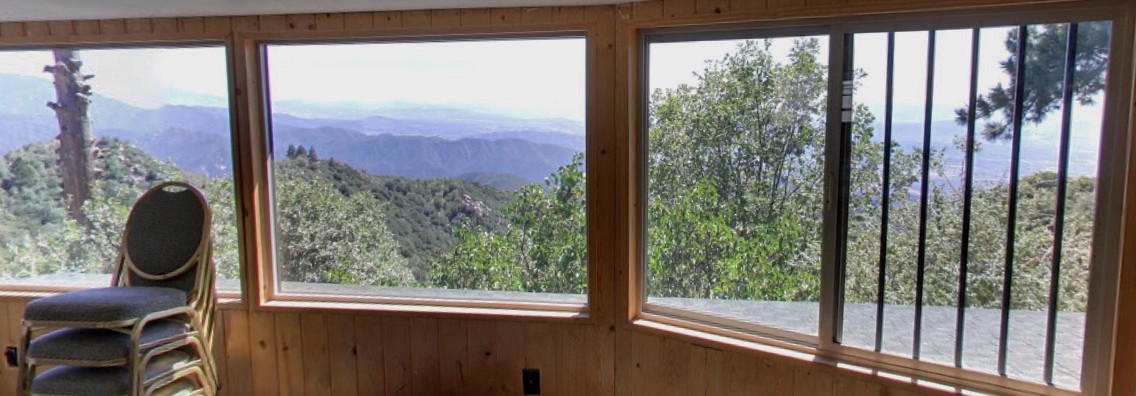 Screenshot from the Dovid Oved Retreat Center?s virtual tour. This game room ? with foosball, ping-pong, and pool ? was previously a CEDU rap room where residents underwent the Synanon ?Game.?
Screenshot from the Dovid Oved Retreat Center?s virtual tour. This game room ? with foosball, ping-pong, and pool ? was previously a CEDU rap room where residents underwent the Synanon ?Game.?
In one of my last efforts at nosing around, I contacted the Dovid Oved Retreat Center. I asked if ex-residents tour the renovated campgrounds. ?[M]any come and visit the site,? the hosting manager quickly replied. I tried to learn more about these visits, but the hosting manager ignored my follow-up. I sent another email, this time admitting a CEDU connection. ?Do survivors tend to come alone or with their families?? I asked. Again, she did not respond.
If we had had a dialogue, I think I would have scheduled my own visit. I still might, independent of hosting managers. Maybe my parents will join me. After all, the retreat center is ?perfect for family reunions,? its website advertises. (Also, according to their handbook, the camp is nut-free. So, if I return to Running Springs, at least I?ll avoid anaphylaxis this time.)
And if anyone questions my presence, I?ll say I?m visiting my childhood home. Maybe I?ll describe it as a ?scandal-ridden boarding school? or a ?drug institute? or ?like Jim Jones?s Guyana? or ?an unregulated prison camp.?
Or, better yet, I?ll just raise my hand and say: ?that was a cult.?
And if that?s not enough, if some proof is demanded, I will share the most striking image of my adolescence: a group photo of four ?at risk? teenagers only at risk at CEDU.
And we?re looking tough, and we?re eating Twizzlers.
